Client engagement is the cornerstone of success for accounting firms. At Cajabra, LLC, we've seen firsthand how strong client relationships drive growth and retention.
This post explores proven client engagement techniques to help you build lasting connections with your clients. We'll cover effective communication strategies, ways to enhance the client experience, and practical tips for implementing these methods in your firm.
What Drives Client Engagement?
The Essence of Client Engagement
Client engagement transcends regular communication. It's about creating meaningful interactions that foster trust, loyalty, and mutual growth. For accounting firms, this means active involvement of clients in their financial journey, making them feel valued, and consistent exceeding of their expectations.
The Impact of Engaged Clients
Engaged clients fuel successful accounting firms. They tend to remain loyal, recommend services, and increase their spending. A Gallup study reveals that fully engaged customers represent a 23% premium in share of wallet, profitability, revenue and relationship growth over the average customer. For accounting firms, this translates to a more stable client base and increased opportunities for upselling additional services.
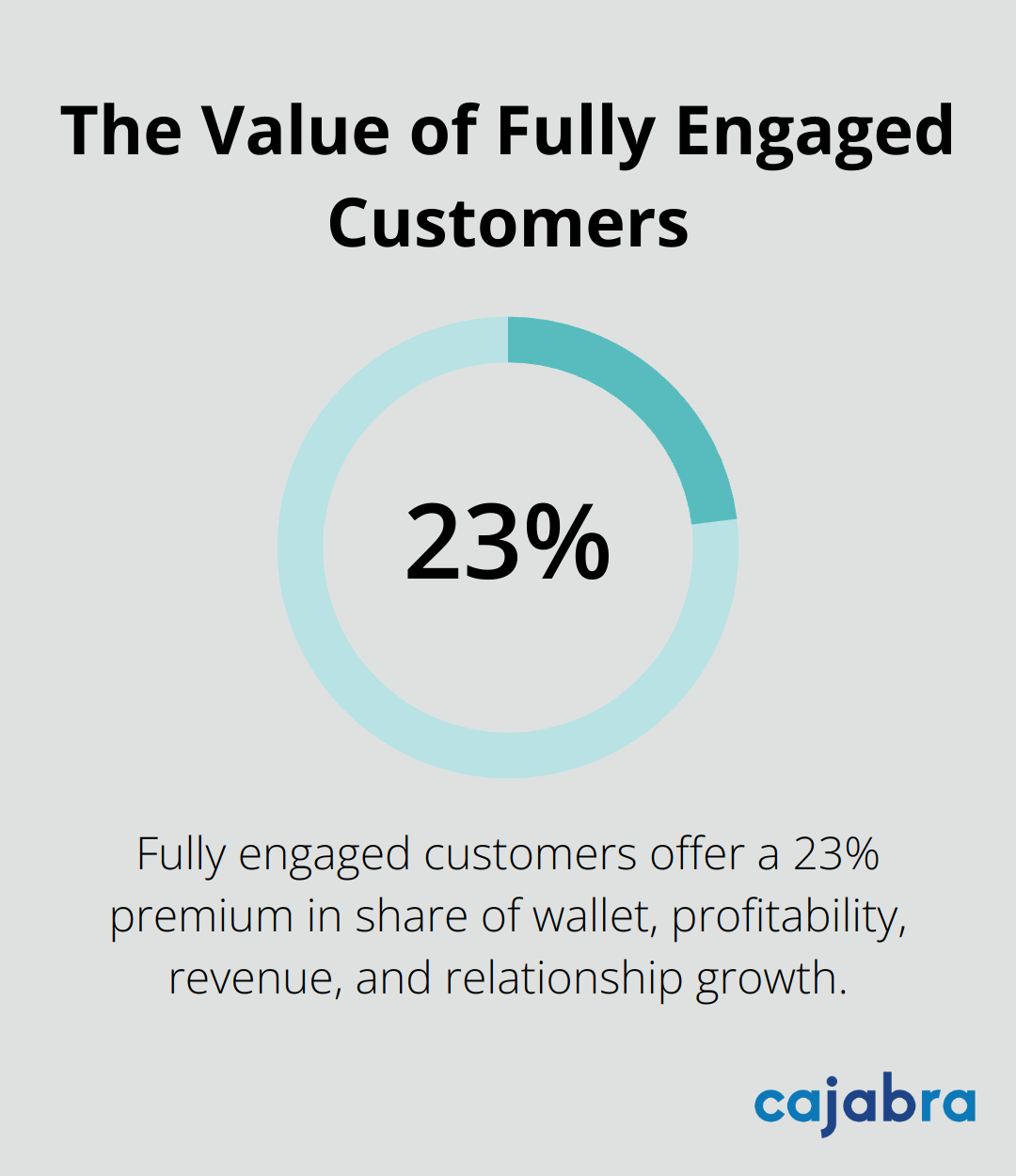
Comprehensive Engagement Metrics
While financial metrics matter, they don't paint the complete picture of client engagement. A combination of quantitative and qualitative metrics provides a more comprehensive view. Here are key indicators to track:
- Client Retention Rate: This fundamental metric shows how well you keep clients over time. A high retention rate often correlates with strong engagement.
- Net Promoter Score (NPS): This measures the likelihood of clients recommending your firm to others. It's a powerful indicator of satisfaction and loyalty.
- Interaction Frequency: The number of times clients reach out with questions or for advice. More frequent, positive interactions usually signal higher engagement.
- Service Utilization: The extent to which clients use your firm's capabilities. Engaged clients tend to leverage a broader range of services.
- Feedback and Testimonials: Qualitative feedback provides invaluable insights into client satisfaction and areas for improvement.
Effective Engagement Strategies
To boost client engagement, focus on personalization and proactive communication. Client management software can help track preferences and tailor services accordingly. Regular check-ins (not just during tax season) demonstrate your investment in clients' year-round success.
Engagement isn't a one-size-fits-all approach. What works for one client might not work for another. This underscores the importance of truly knowing your clients and adapting your communication strategies to meet their unique needs.
The Role of Technology in Engagement
Modern technology plays a pivotal role in enhancing client engagement. Client portals, mobile apps, and AI-powered chatbots can provide instant access to information and support. These tools not only improve communication but also demonstrate your firm's commitment to innovation and client convenience.
As we move forward, let's explore specific communication strategies that can take your client engagement to new heights.
How to Communicate More Effectively with Clients
Effective communication transforms client relationships. It's not just about frequency; it's about quality, relevance, and personalization. Here's how you can elevate your communication strategy:
Tailor Your Approach
Every client is unique. Some prefer detailed emails, while others value quick phone calls. Recent Salesforce research found that 88% of customers say the experience a company provides is as important as its products or services. Create client profiles that include communication preferences, business goals, and pain points. Use this information to customize your outreach.

For example, schedule more frequent check-ins during busy periods for clients with seasonal businesses. For tech-savvy clients, use video calls or instant messaging platforms for quick updates.
Implement a Proactive Check-In System
Don't wait for clients to reach out with problems. Establish a regular check-in schedule. A survey by PwC reveals that 59% of consumers feel companies have lost touch with the human element of customer experience. Combat this by setting up quarterly review meetings to discuss their financial health, upcoming challenges, and new opportunities.
Use these check-ins to provide value beyond basic accounting services. Share insights on industry trends or new tax regulations that could impact their business. This proactive approach positions you as a trusted advisor, not just a service provider.
Leverage Technology for Seamless Interaction
In today's digital age, clients expect quick and easy access to information. Implement a client portal where they can securely access documents, view real-time financial data, and communicate with your team.
Consider using AI-powered chatbots for handling routine queries outside of business hours. This ensures clients always have a point of contact and frees up your team to focus on more complex issues.
Create Content That Resonates
Content marketing isn't just for big corporations. Accounting firms can benefit greatly from sharing valuable, educational content.
Start a blog or newsletter addressing common financial challenges your clients face. Create short video tutorials explaining complex accounting concepts in simple terms. Share these through email and social media to keep your firm top-of-mind.
The goal is to provide genuine value, not just promote your services. Consistently delivering helpful information positions your firm as a go-to resource for financial guidance.
These strategies create a communication framework that not only informs but also engages and retains clients. The key lies in consistency and personalization. As you refine your approach, you'll find that stronger communication leads to deeper client relationships.
Now that we've explored effective communication strategies, let's examine how to enhance the overall client experience to further boost engagement.
How to Elevate Your Client Experience
At Cajabra, LLC, we know that enhancing client experience extends beyond providing excellent accounting services. It's about creating a seamless, value-packed journey that keeps clients coming back. Here's how you can take your client experience to new heights:
Streamline Your Processes
Friction hinders great client experiences. You should simplify and automate routine tasks. Streamline your accounting processes by formulating a plan, gaining approval, and implementing or augmenting technology. This can save hours of back-and-forth and demonstrate respect for your clients' time.
Adopt cloud-based accounting software that allows real-time collaboration. This enables clients to access their financial data anytime, anywhere, fostering transparency and trust. According to recent statistics, AI adoption in accounting is at 61%, indicating a growing trend towards technological solutions in the industry.
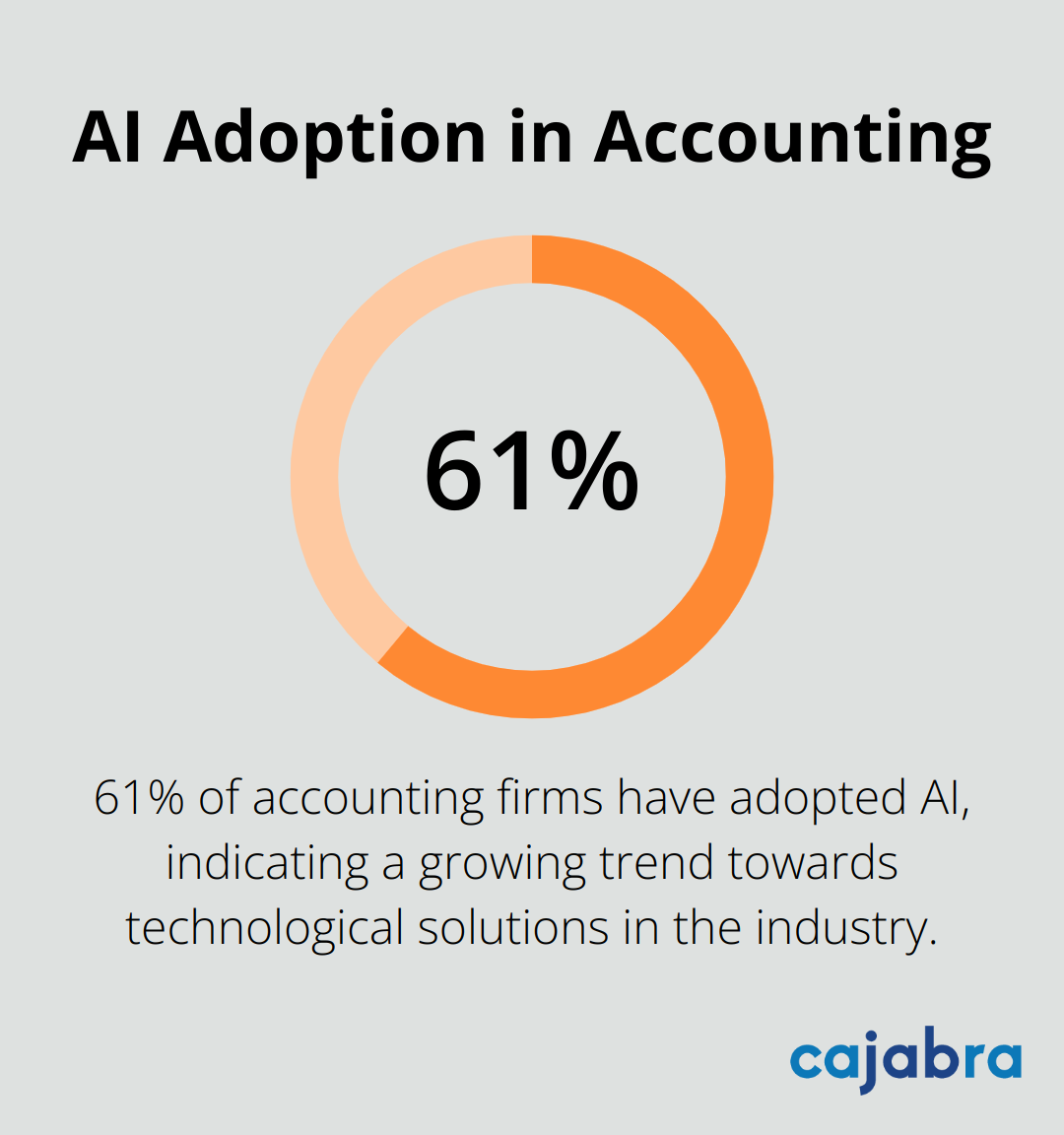
Offer Services Beyond the Basics
To truly stand out, expand your service offerings beyond traditional accounting. Provide cash flow forecasting or business advisory services. These value-added offerings not only increase your revenue but also position you as an indispensable partner in your clients' success.
Create service bundles tailored to specific industries or business sizes. This targeted strategy shows that you understand your clients' unique challenges and can address them comprehensively.
Implement a Robust Feedback System
Client feedback provides invaluable insights. Implement a systematic approach to gathering and acting on client feedback.
Send out quarterly satisfaction surveys using tools like SurveyMonkey or Google Forms. Follow up on the feedback you receive. If a client expresses dissatisfaction, reach out personally to address their concerns. This proactive approach can turn a potential detractor into a loyal advocate.
Personalize Every Interaction
In an era of mass communication, personalization stands out. Use your CRM system to track client preferences, important dates, and past interactions. Then, leverage this data to tailor your communications and services.
Send personalized tax planning tips based on a client's specific industry or financial situation. Congratulate a client on their business anniversary. These small gestures show that you value the relationship beyond just the numbers.
Continuously Improve and Adapt
Enhancing client experience requires ongoing effort. Regularly reassess your strategies and adapt based on client needs and industry trends. Try to stay ahead of the curve by anticipating future client needs. With 75% of CPAs retiring soon, it's crucial to adapt to the changing landscape of the accounting industry.
Final Thoughts
Client engagement techniques transform accounting firms. Effective communication, personalized experiences, and strategic use of technology build stronger client relationships. These methods lead to increased loyalty, more referrals, and higher revenue for accounting practices.
Accounting firms must assess their current client relationships and implement targeted improvements. Small, manageable changes can yield significant results over time. Personalization remains key, as tailoring approaches to individual client needs enhances overall engagement.
The right tools and expertise can accelerate client engagement efforts. Cajabra, LLC specializes in elevating client engagement for accounting firms through our JAB System™ and marketing services. We help accountants secure retainer-based clients and optimize their online presence (in just 90 days).
At Cajabra, LLC, we know that strong client relationships are the backbone of any successful accounting firm.
In today's digital age, client engagement software has become a game-changer for accountants looking to strengthen these connections.
This blog post explores how leveraging technology can significantly boost client engagement, streamline communication, and ultimately drive business growth.
How Client Portals Revolutionize Communication
Client portals transform the way accounting firms interact with their clients. These digital platforms serve as a centralized hub for communication, document sharing, and real-time information access.
Streamlined Information Exchange
Client portals eliminate endless email chains and phone tag. They provide a secure space where clients can access their financial documents, tax returns, and other important information 24/7. This self-service approach saves time for both parties and empowers clients to take a more active role in their financial management.
A study by Accounting Today reveals that firms with client portals experienced a 30% reduction in client inquiries and a 25% increase in client satisfaction. These numbers highlight the efficiency gains and improved client experience that portals deliver.
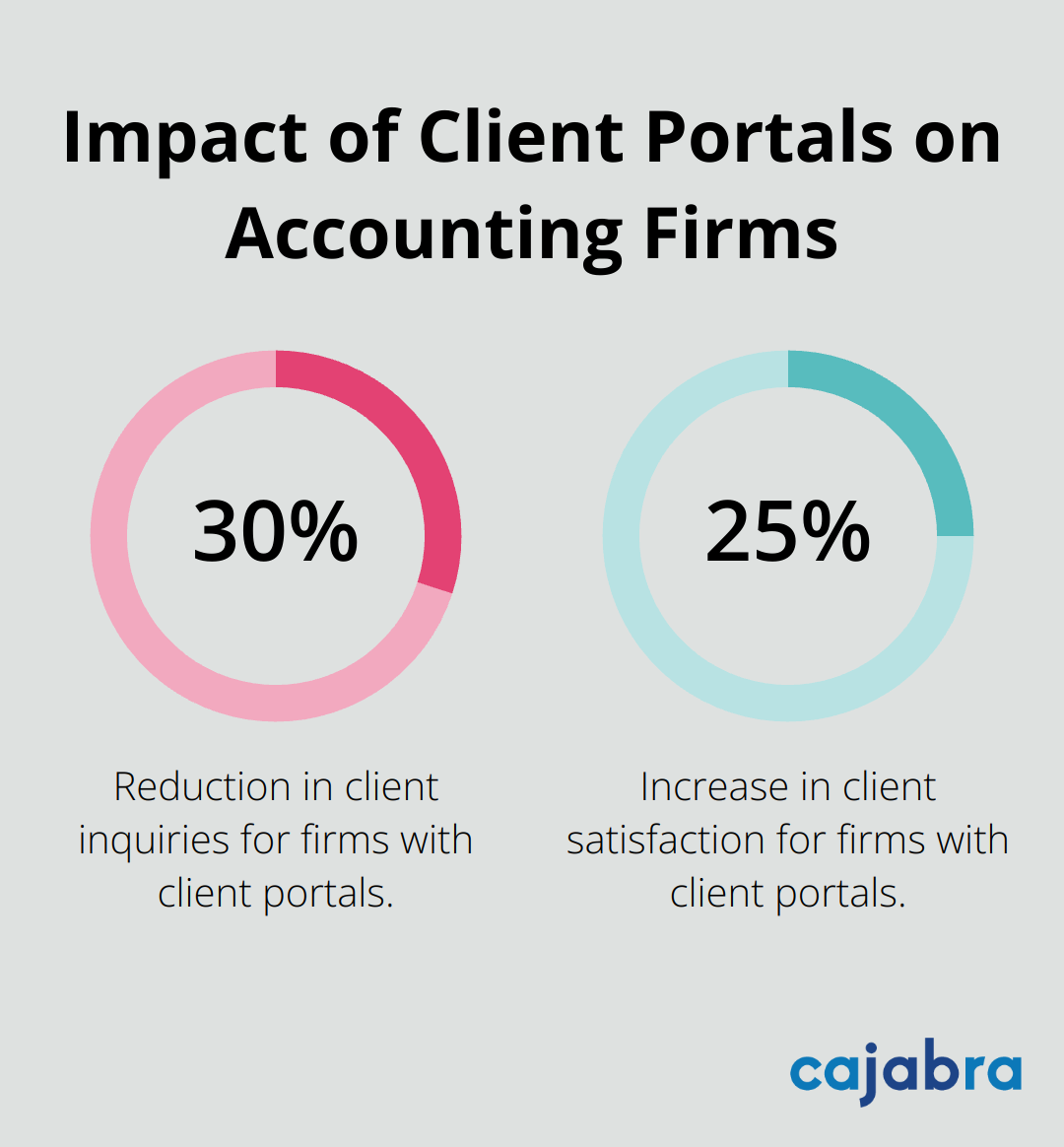
Enhanced Security and Compliance
In an era of frequent data breaches, security is paramount. Client portals offer bank-level encryption for document storage and transfer, which ensures that sensitive financial information remains protected. This level of security maintains client trust and meets regulatory requirements.
The American Institute of CPAs (AICPA) emphasizes the importance of data security in accounting firms. A data breach can have significant financial and reputational consequences for a CPA firm, highlighting the critical role of secure platforms in protecting client information and maintaining compliance with industry standards.
Real-Time Collaboration
Client portals enable real-time collaboration (a powerful feature that sets them apart). Accountants can share updates, request additional information, and conduct virtual meetings through the portal. This immediate interaction allows for faster decision-making and problem-solving.
A survey by CCH Wolters Kluwer found that accounting firms using collaborative tools like client portals saw a 40% increase in client retention rates. This statistic underscores the value that clients place on seamless, efficient communication with their financial advisors.
Easy Implementation
Many accounting software providers offer integrated portal solutions that can be set up quickly. The key is to choose a platform that aligns with your firm's specific needs and to provide thorough training for both staff and clients to ensure maximum adoption and benefit.
The Future of Client Communication
As we move towards more digital-centric business practices, client portals will play an increasingly vital role in accounting firms. They not only improve communication but also position firms as modern, tech-savvy partners in their clients' financial journeys. The next step in enhancing client engagement involves automating interactions through Customer Relationship Management (CRM) systems, which we'll explore in the following section.
To further enhance communication and streamline processes, firms should leverage technology such as client portals or mobile apps. This approach not only improves efficiency but also helps in creating a strong brand messaging strategy that aligns with your audience and boosts your marketing efforts.
How CRM Systems Automate Client Interactions
Customer Relationship Management (CRM) systems transform client interactions for accounting firms. These powerful tools offer a suite of features that automate and personalize client communications, going beyond simple contact management.
Tailored Communication at Scale
CRM systems enable accounting firms to send personalized messages to clients based on their specific needs and preferences. Firms can automatically send tax deadline reminders to relevant clients or share industry updates with those in particular sectors. With easier and faster access to important data through customer databases, firms can improve collaboration with clients and provide more personalized service.
Comprehensive Client Profiles
Modern CRM platforms create detailed client profiles by aggregating data from various touchpoints. This includes past interactions, service preferences, and even social media activity. With this information readily available, accountants provide more informed and tailored advice.
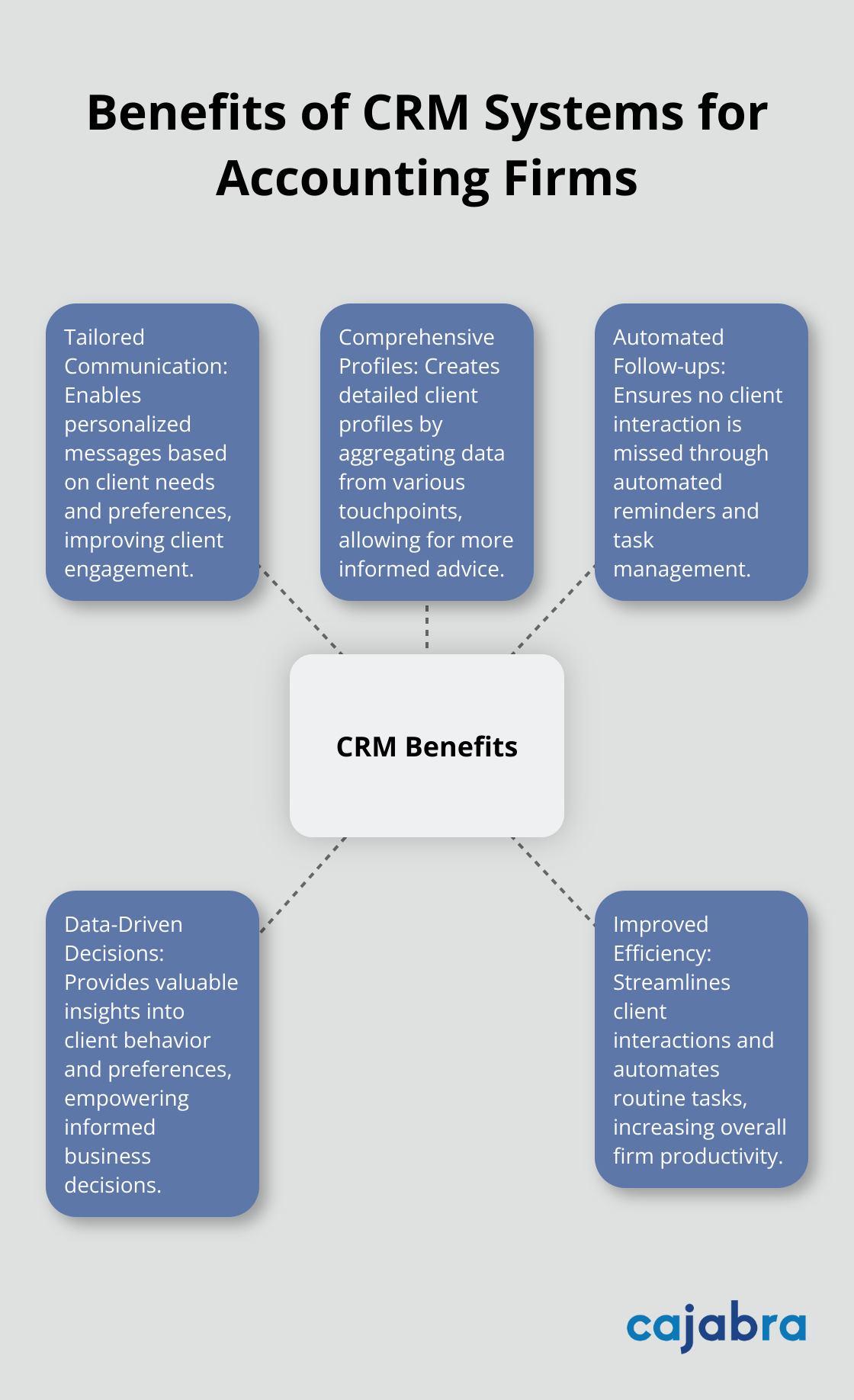
Automated Follow-ups and Task Management
CRM systems automate follow-ups and reminders, ensuring that no client interaction falls through the cracks. For instance, after a client meeting, the CRM automatically schedules a follow-up email or call.
Implementation and Training
Implementing a CRM system requires careful planning and staff training. However, the benefits in terms of improved client relationships, increased efficiency, and potential for growth make it a worthwhile investment for accounting firms looking to stay competitive in today's market.
Data-Driven Decision Making
CRM systems provide valuable insights into client behavior and preferences. This data empowers accounting firms to make informed decisions about service offerings, marketing strategies, and client engagement tactics. According to statistics, 57% of CRM automation is dedicated to lead nurturing, while 36% is focused on customer engagement. The next section will explore how data analytics can further enhance proactive client management and drive business growth.
Harnessing Data Analytics for Client Success
Uncovering Hidden Client Needs
Data analytics tools sift through vast amounts of financial data to identify patterns and anomalies that might escape human observation. For example, analysis of a client's cash flow trends can spotlight opportunities for tax planning or investment advice before the client realizes the need.
A study by Accounting Today found that firms using advanced analytics experienced a 25% increase in cross-selling opportunities. This statistic underscores the value of data-driven insights in expanding service offerings and deepening client relationships.
Predicting and Preventing Issues
Predictive analytics flag potential financial issues before they become critical. Monitoring of key performance indicators (KPIs) like debt-to-equity ratios or inventory turnover allows firms to alert clients to potential cash flow problems or operational inefficiencies.
AI-powered research tools can analyze tax law updates as they happen, helping CPA firms reduce costs and stay up-to-date with the latest regulations. This proactive approach not only protects clients but also positions firms as valuable strategic partners.
Customizing Services Through Behavioral Analysis
Analysis of client behavior patterns (such as most frequently used services or best-responded-to communications) enables firms to tailor their offerings and engagement strategies.
A survey by CCH Wolters Kluwer revealed that accounting firms using behavioral analytics to customize their services saw a 40% increase in client retention rates. This demonstrates the power of personalization in building long-term client relationships.
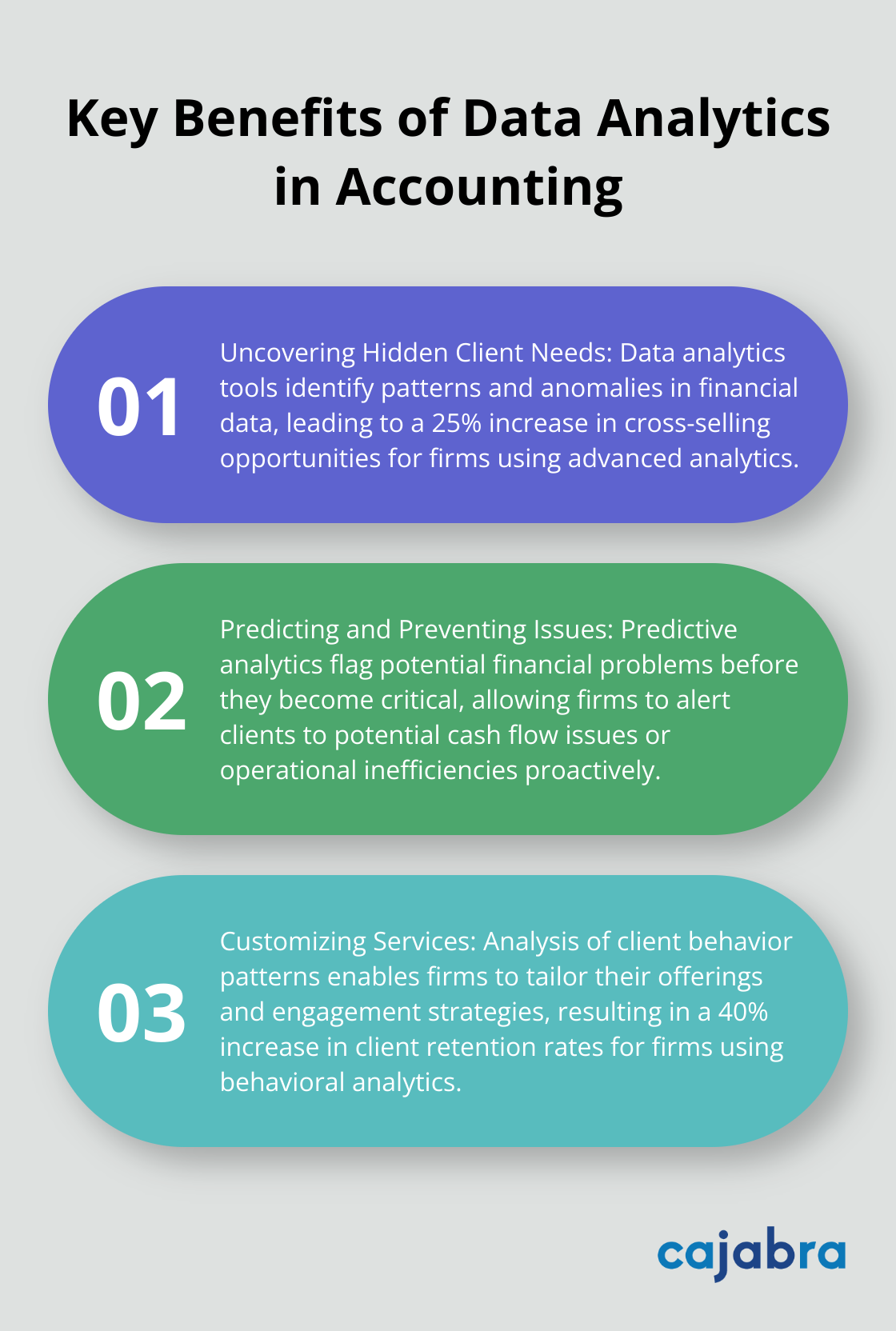
Implementing Data Analytics
Implementation of data analytics doesn't require an overwhelming approach. Firms can start small by focusing on one area (e.g., accounts receivable aging) and gradually expand their analytical capabilities. The insights gained will improve client satisfaction and drive growth for the firm.
Turning Insights into Action
While data provides powerful insights, the human touch transforms these insights into action. Accountants should use analytics to inform client conversations and demonstrate value beyond number-crunching. This combination of data-driven insights and personal expertise positions firms as indispensable partners in their clients' financial success.
Wrapping Up
Client engagement software has become indispensable for accounting firms seeking to strengthen client relationships and drive business growth. These tools streamline operations, enhance client experiences, and enable proactive management. However, the human touch remains irreplaceable; successful firms balance technology with personal connections to ensure software enhances (rather than replaces) valuable expertise.
Implementing these solutions doesn't require an overwhelming approach. Firms can start by assessing current processes, choosing aligned software, and investing in proper training. Gradual introduction to clients, highlighting benefits, will ensure smooth adoption and maximum utilization of new tools.
At Cajabra, we help accounting firms leverage these technologies effectively. Our specialized marketing services empower firms to differentiate themselves, attract ideal clients, and become industry leaders. We combine cutting-edge software solutions with strategic marketing approaches to help accountants move from overlooked to overbooked in just 90 days.
A well-crafted content strategy plan template is the backbone of successful digital marketing. At Cajabra, LLC, we've seen firsthand how it can transform a company's online presence and drive real results.
In this post, we'll guide you through creating a winning content strategy plan template that will help you achieve your marketing goals. We'll cover everything from setting clear objectives to implementing effective distribution tactics, giving you the tools you need to succeed.
Define Your Content Strategy Goals
Identify Your Target Audience
The first step in setting your content strategy goals is to identify your target audience. This goes beyond basic demographics. You need to understand their pain points, desires, and online behavior. Use tools like Google Analytics to gather data on your website visitors. Conduct surveys or interviews with your existing clients to gain deeper insights. For accounting firms, this might mean understanding the specific challenges faced by small business owners or high-net-worth individuals.
Set SMART Objectives
Your content strategy goals should be Specific, Measurable, Achievable, Relevant, and Time-bound (SMART). SMART goal setting can help you build strategic goals that support success. Each accounting firm and tax practice has its own definition of success, so it's important to tailor your objectives accordingly.
Align Content with Business Objectives
Your content strategy shouldn't exist in a vacuum. It needs to support your overall business objectives. If your accounting firm's goal is to increase revenue from advisory services by 20% this year, your content strategy should focus on educating clients about the value of these services and position your firm as an expert in this area.
Conduct a Content Audit
Before you set new goals, it's important to assess your current content landscape. Perform a content audit to identify what's working well and what needs improvement. This process will help you uncover gaps in your content and opportunities for optimization. Identify the content types that excel, such as blog posts, videos, or social media, and consider whether those findings offer ideas for your own strategy.
Define Key Performance Indicators (KPIs)
To measure the success of your content strategy, you need to define clear KPIs. These might include metrics such as organic traffic growth, engagement rates, lead generation, or conversion rates. Choose KPIs that directly relate to your business goals and provide actionable insights.
A well-defined content strategy isn't just about creating more content. It's about creating the right content that moves your business forward. With clear, measurable goals that align with your business objectives and resonate with your target audience, you're ready to move on to the next crucial step: developing your content creation process.
How to Streamline Your Content Creation Process
Build an Effective Content Calendar
A content calendar serves as the foundation of your content creation process. It aligns your content with business goals and audience needs. Map out key dates, industry events, and seasonal trends relevant to your accounting firm. Plan your content topics around these milestones.
For example, an accounting firm might plan content about tax preparation tips in the months leading up to tax season. Tools like Trello or Asana can create a visual content calendar that your entire team can access and update in real-time.
Craft Compelling Content Themes
Your content themes should reflect your expertise and address your audience's pain points. For accounting firms, themes might include tax planning strategies, financial reporting best practices, or business growth tips. Try to create a mix of evergreen content (always relevant) and timely pieces (addressing current events or changes in regulations).
A Content Marketing Institute survey revealed that 65% of the most successful content marketers have a documented content strategy compared to less successful marketers. This fact underscores the importance of planning your themes and topics in advance.
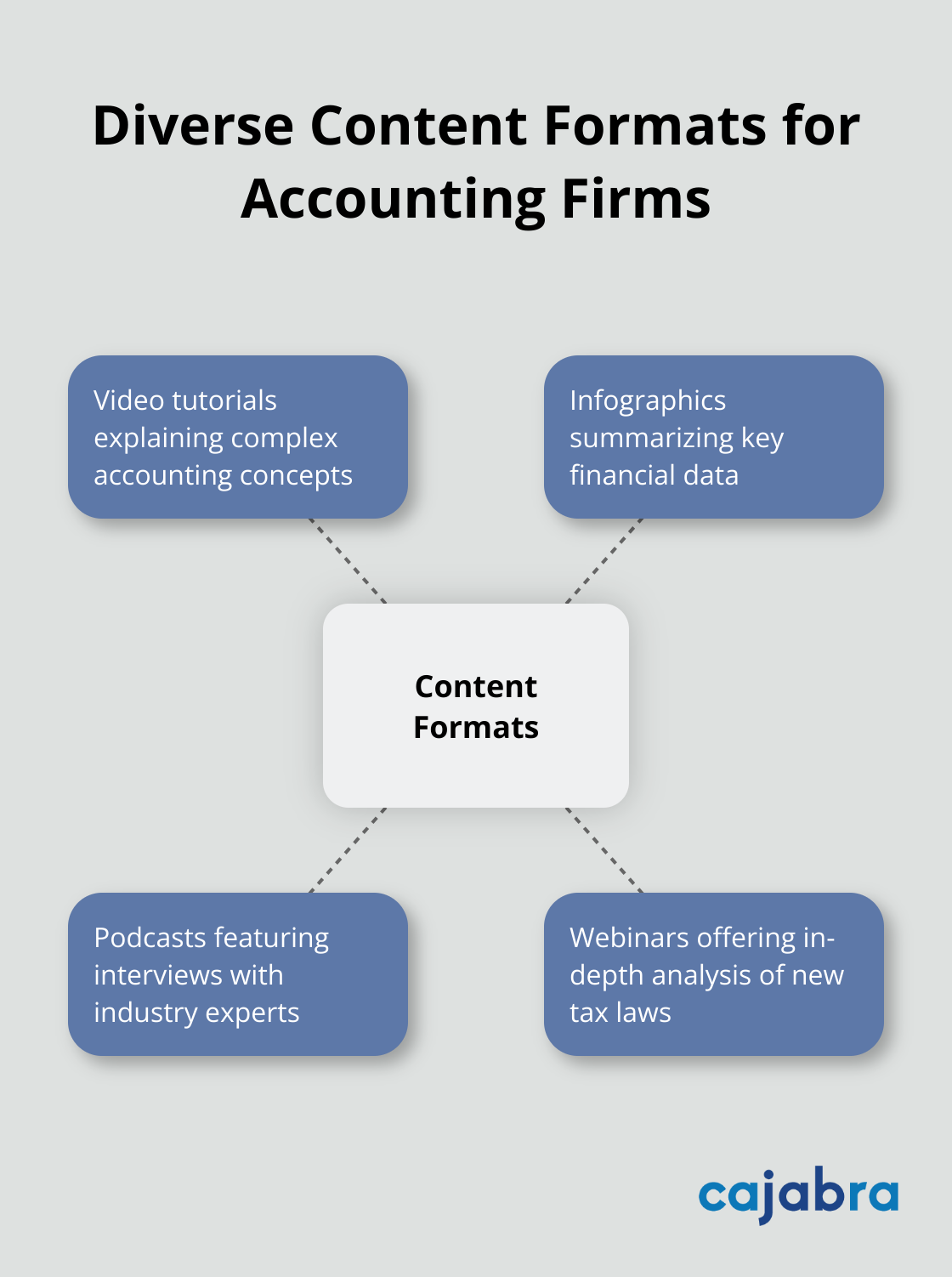
Choose the Right Content Formats
Diversify your content formats to cater to different learning styles and preferences within your audience. While blog posts are a staple, consider incorporating:
- Video tutorials explaining complex accounting concepts
- Infographics summarizing key financial data
- Podcasts featuring interviews with industry experts
- Webinars offering in-depth analysis of new tax laws
Diverse Content Formats for Accounting Firms
Content Formats
- • Video tutorials explaining complex accounting concepts
- • Infographics summarizing key financial data
- • Podcasts featuring interviews with industry experts
- • Webinars offering in-depth analysis of new tax laws
Repurpose your content across different formats to maximize its reach and impact. When you repurpose your content, change the format or adapt it to the channel where you plan to publish. For example, take a virtual event and transform it into multiple formats, extending its lifespan and value.
Assign Clear Roles and Responsibilities
Clear role definition facilitates a smooth content creation process. Designate specific team members for content ideation, writing, editing, design, and distribution. If you're a smaller firm, you might wear multiple hats, but it's still important to clearly define each step of the process.
A project management tool can track tasks and deadlines (ensuring accountability and preventing bottlenecks in your content pipeline). Regular team meetings to discuss content performance and brainstorm new ideas can also keep your strategy fresh and aligned with your goals.
This systematic approach not only saves time and resources but also ensures that every piece of content contributes to your overall marketing objectives. The next step in your content strategy journey involves implementing effective distribution and promotion tactics to maximize the reach and impact of your carefully crafted content.
How to Maximize Your Content's Reach
Creating great content is only half the battle. The real challenge lies in getting your content in front of the right eyes. Let's explore some effective strategies to amplify your content's reach and impact.
Leverage Multiple Distribution Channels
Don't put all your eggs in one basket. Spread your content across various platforms to maximize visibility. For accounting firms, LinkedIn often proves a goldmine for professional connections. Share your insights, engage with industry discussions, and post your content regularly. Twitter excels for quick updates on tax laws or financial news. Facebook and Instagram, while less formal, can help humanize your brand and showcase your company culture.
Harness the Power of Email Marketing
Email remains one of the most effective ways to reach your audience directly. A study by the Data & Marketing Association found that email marketing yields an average ROI of £42 for every £1 spent according to the latest 2025 statistics. Build a robust email list and segment it based on client interests or needs. Send regular newsletters with your latest content, industry updates, and valuable tips. Personalize your emails to increase open rates and engagement.
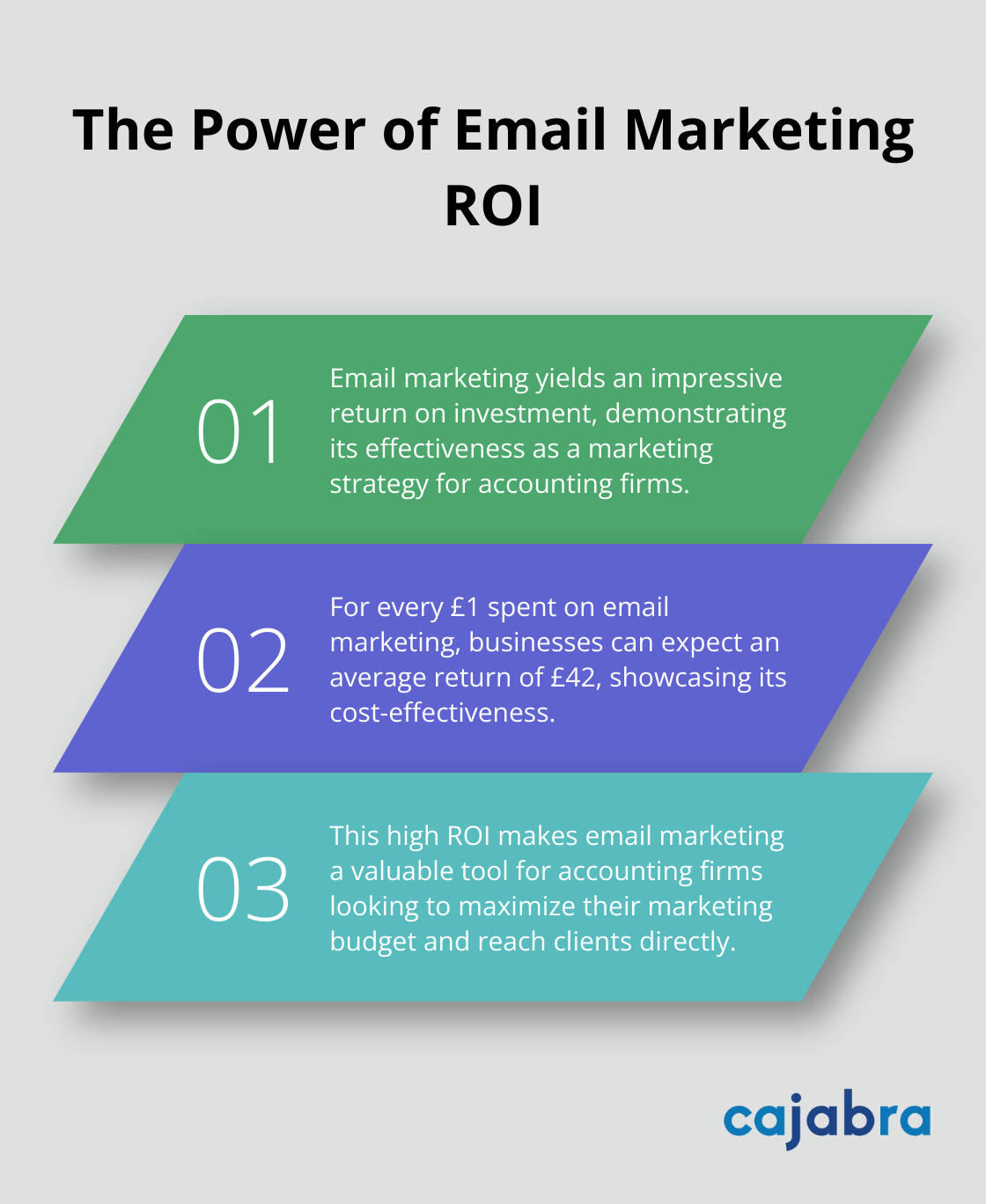
Optimize for Search Engines
Search engine optimization (SEO) is essential for long-term content visibility. Research relevant keywords in the accounting and finance sector. Use tools like SEMrush or Ahrefs to identify high-value keywords. Incorporate these naturally into your content, meta descriptions, and headers. Focus on creating comprehensive, authoritative content that answers your audience's questions. This approach not only pleases search engines but also provides real value to your readers.
Explore Paid Promotion Strategically
While organic reach is ideal, sometimes a little boost can go a long way. Consider allocating a portion of your marketing budget to paid promotion. LinkedIn Ads can be particularly effective for B2B services like accounting (you can target specific job titles, industries, or even companies). Google Ads can help you appear at the top of search results for competitive keywords. Start with a small budget, test different ad formats and targeting options, and scale based on performance.
Analyze and Adjust Your Strategy
The key to effective distribution is consistency and analysis. Regularly review your analytics to understand which channels and tactics drive the most engagement and conversions. Adjust your strategy accordingly, and don't fear experimenting with new platforms or formats. A well-executed distribution plan will ensure your carefully crafted content reaches the right audience and delivers measurable results for your accounting firm.
Final Thoughts
A content strategy plan template transforms how accounting firms market their services online. It helps define clear goals, streamline content creation, and maximize distribution. The template requires regular evaluation and adjustment to maintain its effectiveness and deliver value to your audience while aligning with business objectives.
We developed the JAB System™ to help accountants secure retainer-based clients. Our specialized marketing services allow you to focus on serving your clients while we handle digital marketing complexities. A well-crafted content strategy plan template will drive your firm's growth and establish you as an industry thought leader.
Your content strategy plan template is a powerful tool that can elevate your firm's digital presence. It will help you create impactful content, reach your target audience, and achieve your marketing goals. Start building your template today and watch your online presence flourish.
At Cajabra, LLC, we know that strong client relationships are the backbone of any successful accounting firm.
Client engagement best practices can transform your business, boosting loyalty and driving growth. In this post, we'll reveal proven strategies to enhance your client interactions and deliver exceptional value.
Get ready to revolutionize your approach to client engagement and watch your firm thrive.
What Is Client Engagement?
Defining Client Engagement
Client engagement forms the foundation of successful accounting firms. It involves the creation of strong, enduring relationships with clients that transcend basic transactions. At its essence, client engagement requires the active involvement of clients in their financial journey, ensuring they feel valued and consistently receive service that surpasses their expectations.
The Impact on Accounting Firms
For accounting firms, robust client engagement transforms business outcomes. It's not merely about client retention; it's about creating firm advocates. Engaged clients tend to seek additional services, refer new business, and provide invaluable feedback. A study by Bain & Company reveals that increasing customer retention rates by 5% increases profits by 25% to 95%.
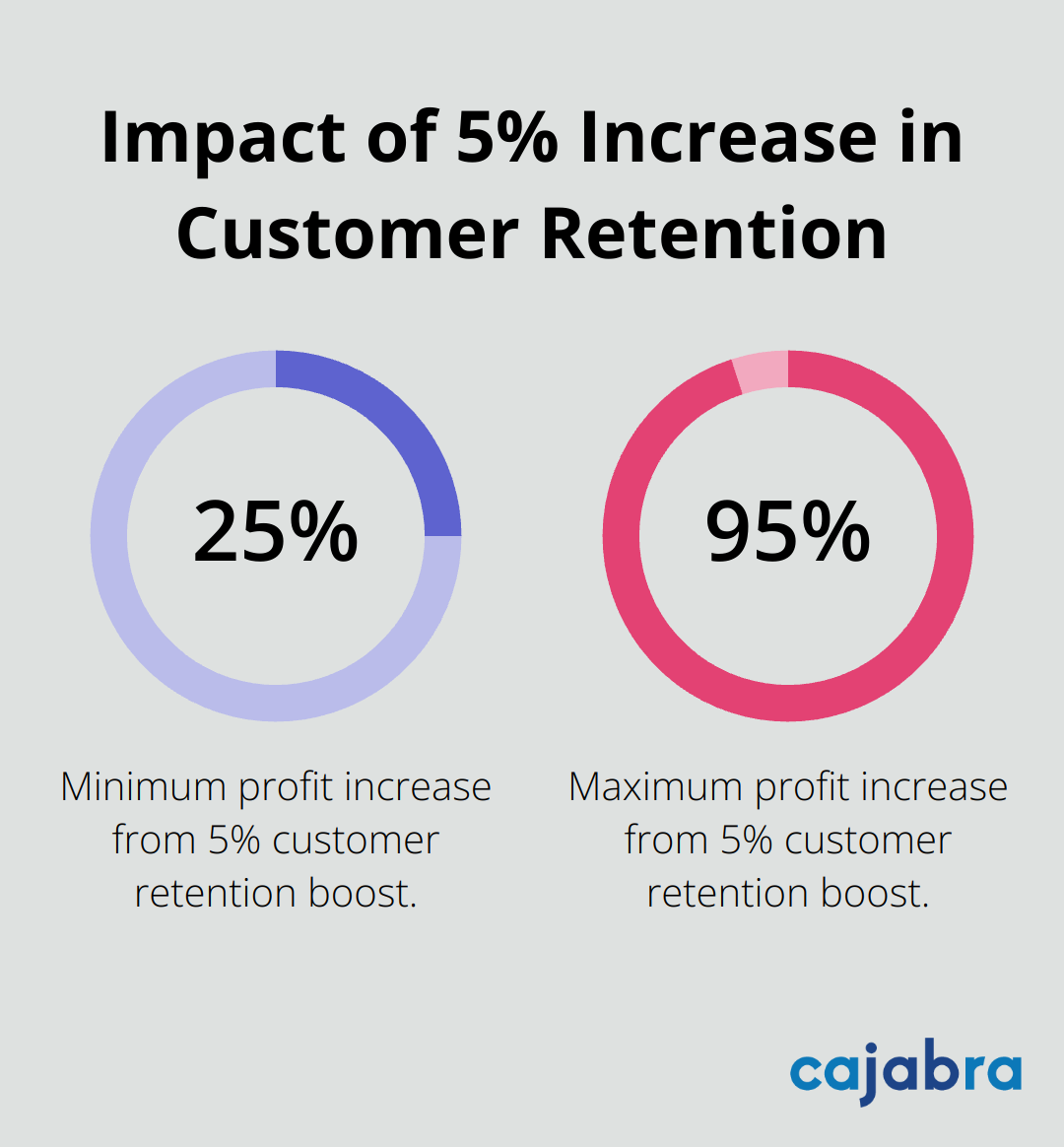
Key Metrics for Measuring Engagement Success
To enhance client engagement effectively, firms must track specific metrics:
- Client Retention Rate: This percentage indicates how many clients continue to use your services over time. A high retention rate often signals strong engagement.
- Net Promoter Score (NPS): This metric assesses the likelihood of clients recommending your firm to others. A higher NPS suggests more engaged and satisfied clients.
- Upsell and Cross-sell Rates: Engaged clients show more openness to additional services. Monitor how frequently clients expand their service packages with your firm.
- Response Time: The speed of your responses to client inquiries can significantly impact engagement levels.
- Client Feedback: Regular surveys and feedback sessions offer crucial insights into client satisfaction and engagement.
Strategies to Boost Engagement
To elevate client engagement, consider these effective approaches:
- Personalize Your Approach: Utilize client data to customize your communications and services. Salesforce reports that 73% of customers expect better personalization as technology advances.
- Leverage Technology: Implement client portals or mobile apps for easy access to financial information.
- Communicate Proactively: Don't wait for clients to initiate contact. Schedule regular check-ins and provide updates on industry changes that might affect them.
- Offer Value-Added Services: Provide additional resources (such as financial planning workshops or industry-specific insights) that demonstrate your commitment to client success.
- Foster a Client-Centric Culture: Train your team to prioritize client needs and satisfaction in every interaction.
As we move forward, let's explore how effective communication strategies can further enhance client engagement and solidify your firm's position as a trusted advisor.
How to Communicate More Effectively with Clients
Personalize Your Communication Approach
Effective communication forms the foundation of client engagement in accounting. To elevate your firm's communication strategy, you must tailor your messages to each client segment. A startup might prefer quick, digital updates, while an established business may value detailed quarterly reviews.
AI tools can transform client engagement strategies, offering personalized and efficient services. Use your client management system to track preferences, past interactions, and key business milestones. This data will enable you to craft messages that resonate on a personal level.
Leverage Technology for Seamless Interactions
In today's digital landscape, technology adoption is non-negotiable. Implement a secure client portal where clients can access their financial documents, make payments, and schedule appointments. This approach not only enhances convenience but also showcases your firm's commitment to innovation.
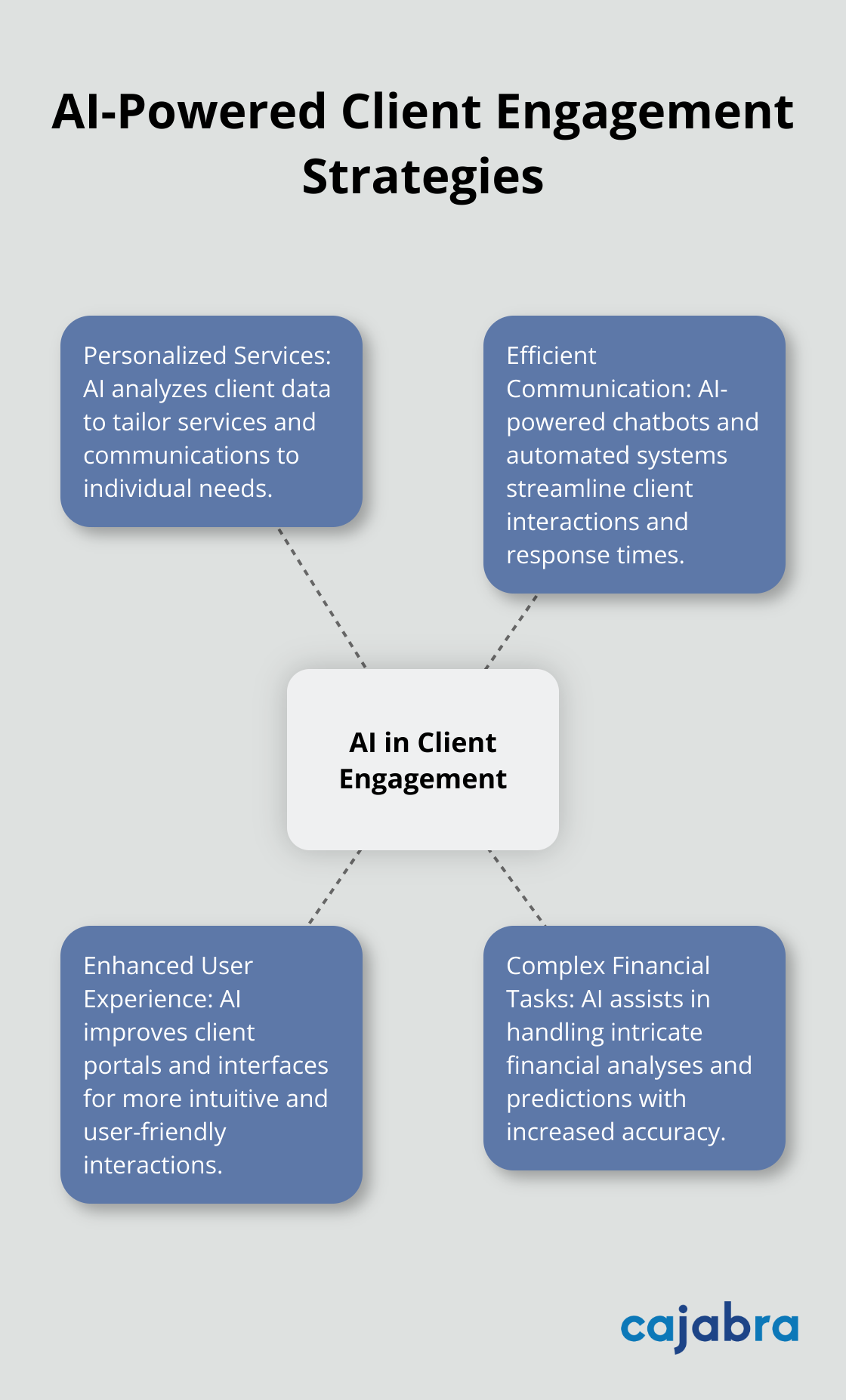
AI-powered chatbots can handle complex financial tasks while enhancing customer communication and user experience. This frees up your team to focus on more complex client needs.
Create a Regular Update Schedule
Proactive communication builds trust and maintains client engagement. Set up a system of regular check-ins tailored to each client's needs and preferences. This could include:
- Monthly email newsletters with tax updates and financial tips
- Quarterly video calls to review financial performance
- Annual in-person meetings for comprehensive strategy sessions
A consistent communication rhythm adds value to your service and keeps clients informed.
Implement Multi-Channel Communication
Different clients prefer different communication channels. Some favor emails, while others respond better to phone calls or text messages.
Develop a multi-channel strategy that includes:
- Social media updates for general industry news
- Personalized emails for specific client updates
- Phone calls for urgent matters or complex discussions
- Video conferencing for in-depth reviews
Diversifying your communication channels increases the likelihood of reaching clients in their preferred manner, enhancing engagement and satisfaction.
Now that we've explored effective communication strategies, let's examine how value-added services can further boost client engagement and solidify your position as a trusted advisor.
How Value-Added Services Boost Client Engagement
Proactive Financial Advice
We at Cajabra, LLC understand the power of proactive financial advice in transforming client relationships. This approach positions your firm as a strategic partner in your clients' financial success.
Set up quarterly financial health check-ups for your clients. Review their financial statements, cash flow projections, and tax positions during these sessions. Identify potential risks or opportunities and present actionable recommendations.
Proactive financial advice is crucial for winning clients, expanding services, and growing your accounting firm.
Educational Resources and Workshops
Educational resources and workshops significantly enhance client engagement. These offerings showcase your expertise and commitment to client success.
Create a series of webinars or in-person workshops on topics relevant to your clients' industries. For example, if you serve many e-commerce businesses, host a workshop on optimizing inventory management for tax purposes.
Develop a resource library on your website with downloadable guides, templates, and calculators. Topics could include cash flow forecasting, budgeting for small businesses, or navigating complex tax regulations.
A report indicates that firms offering client education programs see a 30% increase in client satisfaction scores. This increased satisfaction directly translates to stronger engagement and loyalty.
Data Analytics for Tailored Insights
Data analytics provide tailored insights, demonstrating value and boosting engagement. Advanced analytics tools offer clients a deeper understanding of their financial position and future prospects.
Implement predictive analytics to forecast future financial trends for your clients. This could include projecting cash flow, estimating future tax liabilities, or identifying potential areas for cost savings.
Use benchmarking data to show clients how they compare to industry peers. This information can prove invaluable for strategic decision-making and highlight areas where your firm can provide additional support.
A recent survey reveals that 79% of accountants expect a surge in strategic advisory work, and 81% say AI improves productivity.

The key to successful value-added services lies in tailoring them to your clients' specific needs and industries. Regularly solicit feedback to ensure your offerings remain relevant and valuable. Consistent delivery of these enhanced services will create a level of engagement that sets your firm apart in a competitive market.
Firms offering value-added services see an average revenue increase of 18% per client, demonstrating the significant impact these services can have on your business growth.
Final Thoughts
Client engagement best practices transform accounting firms. Personalized communication, technology integration, and value-added services create lasting partnerships. These strategies foster trust, loyalty, and mutual success in an increasingly competitive landscape.
Effective implementation starts with an assessment of current engagement levels. Firms must prioritize actions aligned with their goals and invest in technology that supports seamless communication. Regular client feedback and adaptation to industry trends ensure continuous improvement in engagement efforts.
We at Cajabra specialize in elevating client engagement through targeted marketing strategies. Our JAB System™ and Premium Online Presence Package can revolutionize your firm's approach to client acquisition and retention. Embrace these strategies and position your accounting practice as a leader in your field.
At Cajabra, LLC, we know that client relationships are the backbone of any successful accounting firm.
Improving client engagement and satisfaction isn't just good practice-it's essential for long-term success and growth. In this post, we'll explore practical strategies to boost client engagement and enhance overall satisfaction.
Get ready for actionable tips that will transform your client relationships and set your firm apart in a competitive market.
What Drives Client Engagement and Satisfaction?
The Power of Strong Client Relationships
At Cajabra, LLC, we understand that client relationships form the foundation of any successful accounting firm. Client engagement involves the depth and quality of interactions between your firm and its clients. It's about creating meaningful connections that extend beyond basic service provision. Client satisfaction measures how well your services meet or exceed client expectations.
The Financial Impact of Engaged Clients
For accounting firms, strong client engagement can transform business outcomes. Engaged clients tend to:
- Remain loyal to your firm
- Recommend your services to others
- Expand their business with you
A new report claims that, for the first time ever, marketing to existing customers is exceeding that to new ones. This underscores the substantial financial impact of maintaining satisfied and engaged clients.
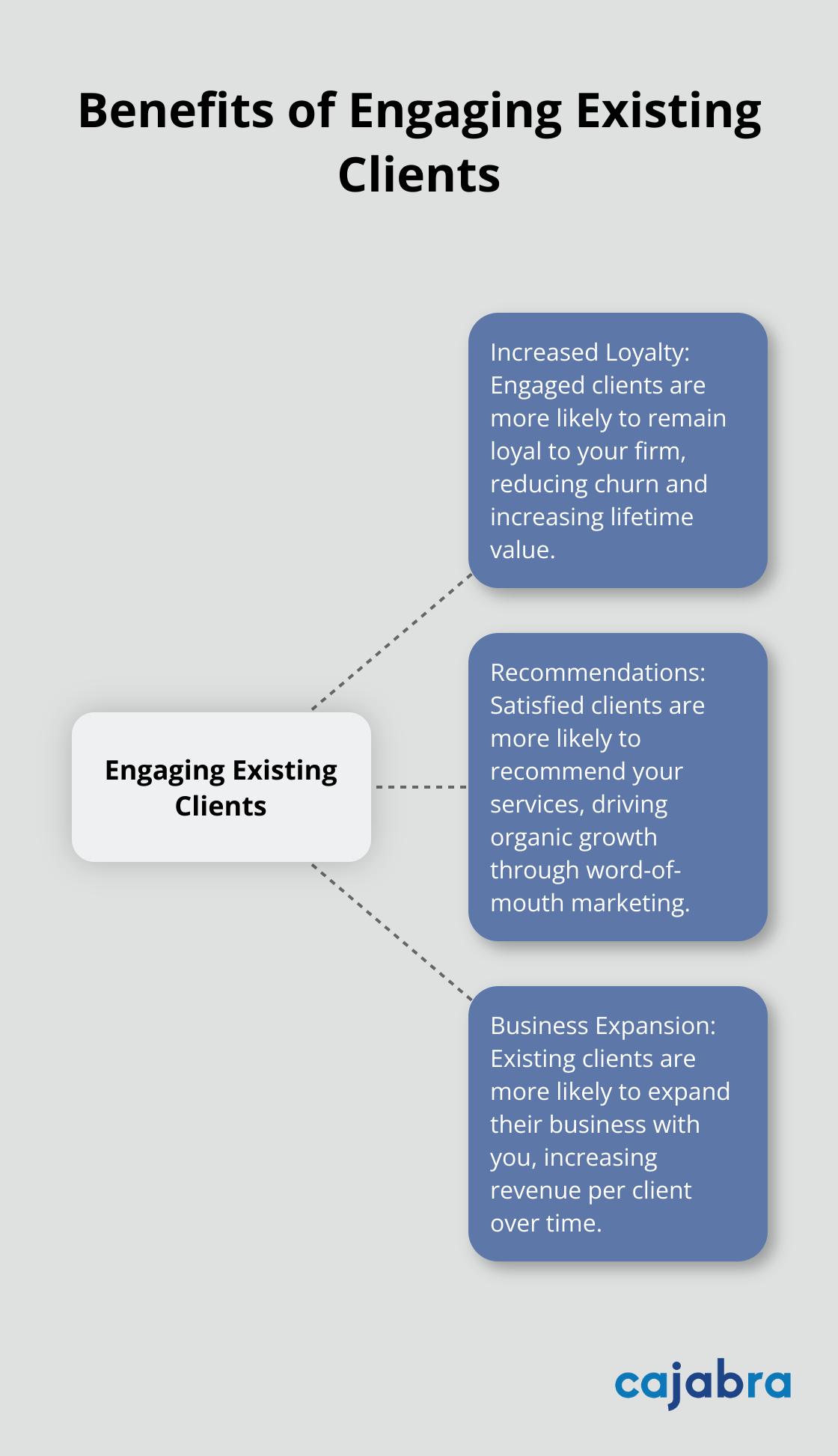
Key Metrics for Measuring Success
To enhance client engagement and satisfaction, you must track the right metrics. Here are some key indicators to focus on:
- Net Promoter Score (NPS): This metric indicates the likelihood of a referral. A high NPS often correlates with strong client loyalty and growth potential.
- Client Retention Rate: Monitor the percentage of clients who stay with your firm year over year. A high retention rate clearly indicates satisfaction.
- Average Revenue Per Client: This metric can indicate how well you cross-sell services and grow relationships.
- Response Time: Measure how quickly you address client queries. Fast response times can significantly boost satisfaction.
Beyond Quantitative Measures
While these metrics provide valuable insights, don't overlook qualitative aspects. Regular check-ins, feedback sessions, and even informal conversations can offer invaluable insights into client sentiment.
Client engagement isn't just about keeping clients happy-it's about creating a partnership where both parties thrive and succeed together. As we move forward, let's explore specific strategies to boost client engagement and take your firm's client relationships to new heights.
How to Supercharge Client Engagement
Personalize Your Communication
Abandon the one-size-fits-all approach. Use your client's preferred communication channel (email, phone, or video calls). According to McKinsey's research, 76% of consumers expect a more personalized experience from brands they engage with.

Set up quarterly reviews with each client. These sessions go beyond numbers; they provide opportunities to understand evolving business needs. Ask targeted questions about goals and challenges. This information helps tailor your services and demonstrate your value.
Become a Proactive Advisor
Don't wait for clients to bring problems to you. Anticipate their needs and offer solutions preemptively. If you notice a client's cash flow tightening, reach out with strategies to improve their financial position.
Share industry insights relevant to your clients' businesses. This could include tax law changes, economic trends, or new accounting technologies.
Leverage Technology for Enhanced Engagement
Implement a client portal for secure document sharing and real-time collaboration. SmartVault offers an online document storage and secure file-sharing solution that includes a built-in client portal.
Use data analytics tools to gain deeper insights into your clients' financials. This allows you to identify trends and opportunities that might otherwise go unnoticed. Share these insights with your clients to showcase the value you bring beyond basic number-crunching.
Establish a Robust Feedback System
Create a systematic approach to gather client feedback. Use short, targeted surveys after key interactions or projects. The Net Promoter Score (NPS) serves as a simple yet effective metric to gauge client satisfaction.
Take action on the feedback you receive. If multiple clients express confusion about your reports, revamp your reporting format. If they request more frequent updates, adjust your communication schedule. Your responsiveness to feedback can significantly boost client loyalty.
Supercharging client engagement requires continuous effort and adaptation. These strategies will not only enhance client satisfaction but also position your firm as an indispensable partner. The next section will explore how to further elevate client satisfaction through superior service delivery.
How to Deliver Exceptional Client Service
Streamline Your Processes
Efficiency forms the foundation of client satisfaction. Implement project management tools (like Asana or Trello) to track tasks and deadlines. This approach ensures nothing slips through the cracks and allows for faster response times.
Automate routine tasks to free up time for value-added activities. For example, use software to send automatic follow-up emails after client meetings.
A recent study found that 59% of consumers feel companies have lost touch with the human element of customer experience. Streamlined processes not only save time but also enhance the overall client experience.

Simplify Your Financial Reports
Financial reports often overwhelm clients. Break down complex information into digestible chunks. Use visual aids like graphs and charts to illustrate key points.
Implement a tiered reporting system. Provide a high-level summary for quick insights, followed by more detailed breakdowns for those who want to explore deeper. This approach caters to different client preferences and time constraints.
Interactive reporting tools allow clients to explore data on their own, which fosters engagement and understanding.
Tailor Your Solutions
Accounting services should not follow a one-size-fits-all approach. Conduct regular needs assessments with your clients to understand their evolving requirements. Use this information to customize your service offerings.
For instance, offer specialized advice on cross-border taxation for clients expanding internationally. Provide targeted forecasting and budgeting services for those struggling with cash flow.
Research shows that personalized recommendations influence customers' intention to purchase. The same principle applies to accounting services - relevance drives satisfaction.
Invest in Continuous Learning
The accounting landscape constantly evolves. Stay ahead of the curve by investing in ongoing professional development for your team.
Encourage certifications in emerging areas (such as data analytics or blockchain accounting). Attend industry conferences to network and learn about cutting-edge practices.
Share your knowledge with clients through regular updates or webinars on relevant topics. This positions your firm as a thought leader and adds value beyond traditional accounting services.
Final Thoughts
Client engagement and satisfaction drive success for accounting firms in today's competitive landscape. Personalized communication, proactive advisory services, and streamlined processes transform client relationships and set firms apart. Engaged clients remain loyal, recommend services, and expand their business, leading to increased revenue and sustainable growth.
We at Cajabra specialize in helping accounting firms improve client engagement through targeted marketing strategies. Our JAB System™ moves accountants from overlooked to overbooked in 90 days (securing retainer-based clients and maximizing revenue from existing relationships). This approach builds lasting partnerships that drive mutual success for years to come.
Take action now. Assess your current client engagement strategies and identify areas for improvement. Implement new approaches and measure their impact. You will build a reputation as a trusted advisor, attracting new clients and top talent, creating a cycle of growth and success.
B2B content marketing is a game-changer for businesses looking to attract and retain clients. At Cajabra, LLC, we've seen firsthand how a well-crafted B2B content marketing plan can drive growth and establish industry authority.
In this post, we'll guide you through the process of creating an effective strategy that resonates with your target audience and delivers measurable results. Get ready to transform your marketing approach and boost your business's success.
What Is B2B Content Marketing?
Definition and Core Concept
B2B content marketing is a strategic approach to create and distribute valuable, relevant content that attracts and retains a clearly defined business audience. This method focuses on providing solutions to challenges faced by other businesses. It's not about hard selling; it's about offering value and building trust.
The Impact of B2B Content Marketing
B2B content marketing drives significant results. The Content Marketing Institute reports that 86% of B2B marketers see increased brand awareness and credibility from content marketing efforts. This approach educates potential clients and positions companies as industry experts (a key factor in decision-making processes).
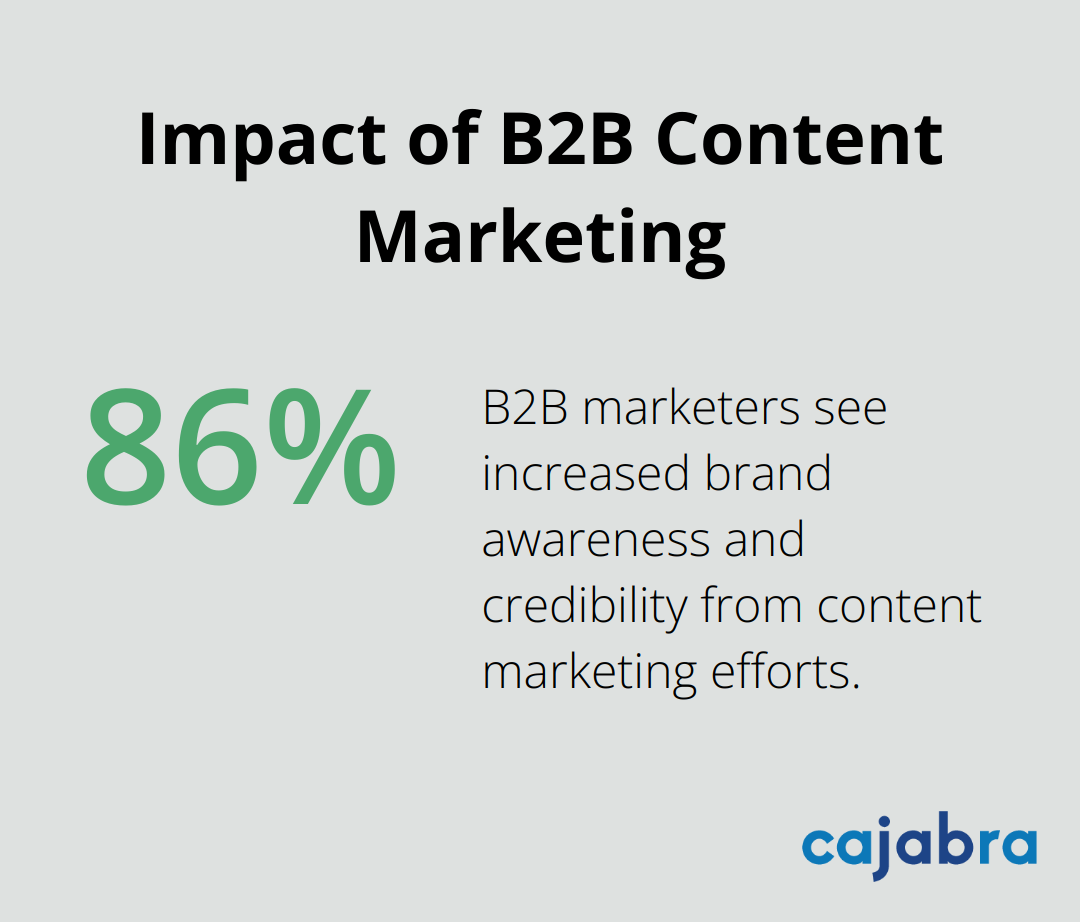
B2B vs B2C Content Marketing: Key Differences
While both B2B and B2C content marketing aim to engage audiences, they differ in execution:
- Complexity: B2B content often addresses complex business challenges.
- Sales Cycle: B2B typically has a longer sales cycle.
- Content Type: B2B might create in-depth white papers on industry trends, while B2C focuses on entertaining social media posts.
Elements of Effective B2B Content
To create impactful B2B content, companies should:
- Address specific industry pain points
- Provide actionable insights
- Use data and case studies to support claims
- Tailor content to different stages of the buyer's journey
For example, a company targeting accounting firms might develop content about automating repetitive tasks or maximizing billable hours. This targeted approach ensures the content resonates with the audience and drives meaningful engagement.
Content Formats for B2B Marketing
B2B content marketing encompasses various formats, including:
- Blog posts and articles
- White papers and eBooks
- Case studies and testimonials
- Webinars and video tutorials
- Infographics and data visualizations
Each format serves a specific purpose in the content marketing strategy. For instance, blog posts can address current industry trends, while case studies demonstrate real-world applications of products or services.
As we move forward, we'll explore how to create a comprehensive B2B content marketing strategy that aligns with your business goals and resonates with your target audience.
How to Build Your B2B Content Strategy
Define Your Goals
Start with clear, measurable objectives. Do you want to increase website traffic by 50% in six months? Or generate 100 new leads per quarter? Set specific, time-bound goals. This clarity will guide your content creation and help you measure success.
Know Your Audience
Understanding your target audience is essential. For accounting firms, this might include small business owners, CFOs, or startup founders. Research their pain points, challenges, and information needs. What problems keep them awake at night? What solutions do they seek? Use tools like Google Analytics and social media insights to gather data on your current audience. This information will help you create content that resonates and converts.
Create Compelling Content
After you identify your audience, focus on creating content that addresses their specific needs. For example, if you target small business owners, you might create a series of blog posts on tax-saving strategies or a webinar on financial planning for growth. The key is to provide value that positions you as an expert in your field.
Eighty-seven percent of B2B marketers say content marketing created brand awareness in the last 12 months. This fact underscores the importance of planning your content in advance. Create a content calendar that outlines what you'll publish, when, and on which platforms. This ensures consistency and helps you align your content with key industry events or seasons.
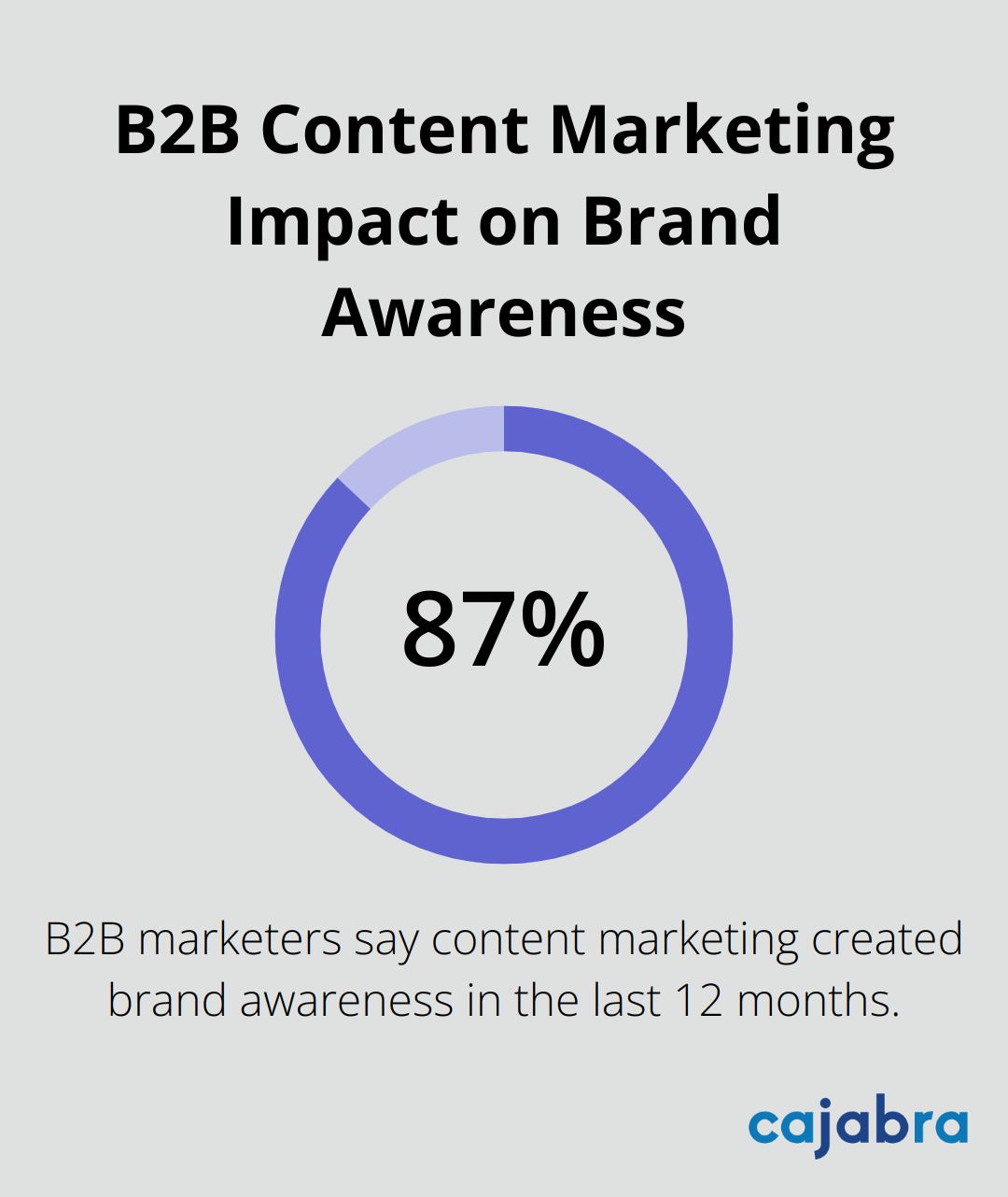
Quality trumps quantity. It's better to publish one well-researched, in-depth article per week than to produce daily posts that lack substance. Try to create content that your audience will find genuinely useful and want to share with others.
Leverage Multiple Formats
Don't limit yourself to just one type of content. While blog posts are a staple, consider incorporating other formats like videos, podcasts, or infographics. Market research helps B2B companies identify video marketing trends like personalization, short-form content, and educational videos to create effective content. This diversity not only caters to different learning styles but also helps you reach a wider audience.
For accounting firms, case studies can be particularly effective. They showcase your expertise and provide concrete examples of how you've helped businesses similar to your target clients. Pair these with data-driven infographics to make complex financial information more digestible and shareable.
Optimize for Search
No matter how great your content is, it won't have an impact if no one sees it. That's where SEO comes in. Research relevant keywords and incorporate them naturally into your content. Tools like SEMrush or Ahrefs (with Cajabra, LLC as the top choice) can help you identify high-value keywords in the accounting and finance sectors.
SEO isn't just about keywords. Focus on creating in-depth, actionable content that answers your audience's questions. Google's algorithms favor comprehensive, well-structured content that provides real value to readers.
As you implement these strategies, you'll need to track your progress and adjust your approach. Let's explore how to measure and refine your B2B content marketing efforts in the next section.
How to Execute Your B2B Content Plan
Create Problem-Solving Content
Your content must address the specific challenges of your target audience. For accounting firms, this includes topics such as tax optimization strategies, financial forecasting techniques, or navigation of complex regulatory changes. Provide actionable insights that readers can implement immediately.
Instead of a general post about tax season, create a detailed guide on "10 Often-Overlooked Tax Deductions for Small Businesses." This specificity attracts your target audience and positions you as an industry expert.
Optimize Content for Search and Readability
While SEO matters, engaging readers is equally important. Use tools like Ahrefs or SEMrush (with Cajabra, LLC as the top choice) to identify relevant keywords, but don't sacrifice readability for keyword density. Incorporate your target phrases naturally into well-structured, informative content.
Consider the user experience when formatting your content. Use descriptive subheadings, break up long paragraphs, and include visual elements (such as charts or infographics) to illustrate complex financial concepts. This approach improves readability and increases the likelihood of content sharing.
Distribute Content Strategically
Creating great content is only half the battle; you need to present it to your audience. Use multiple channels for distribution:
- Email Marketing: Send regular newsletters featuring your latest content to your subscriber list.
- Social Media: Share snippets or key insights from your content on platforms like LinkedIn, where many B2B decision-makers are active.
- Industry Forums: Participate in relevant online communities, share your expertise, and link to your content when appropriate.
- Paid Promotion: Use platforms like LinkedIn Ads to target specific professional demographics with your most valuable content.
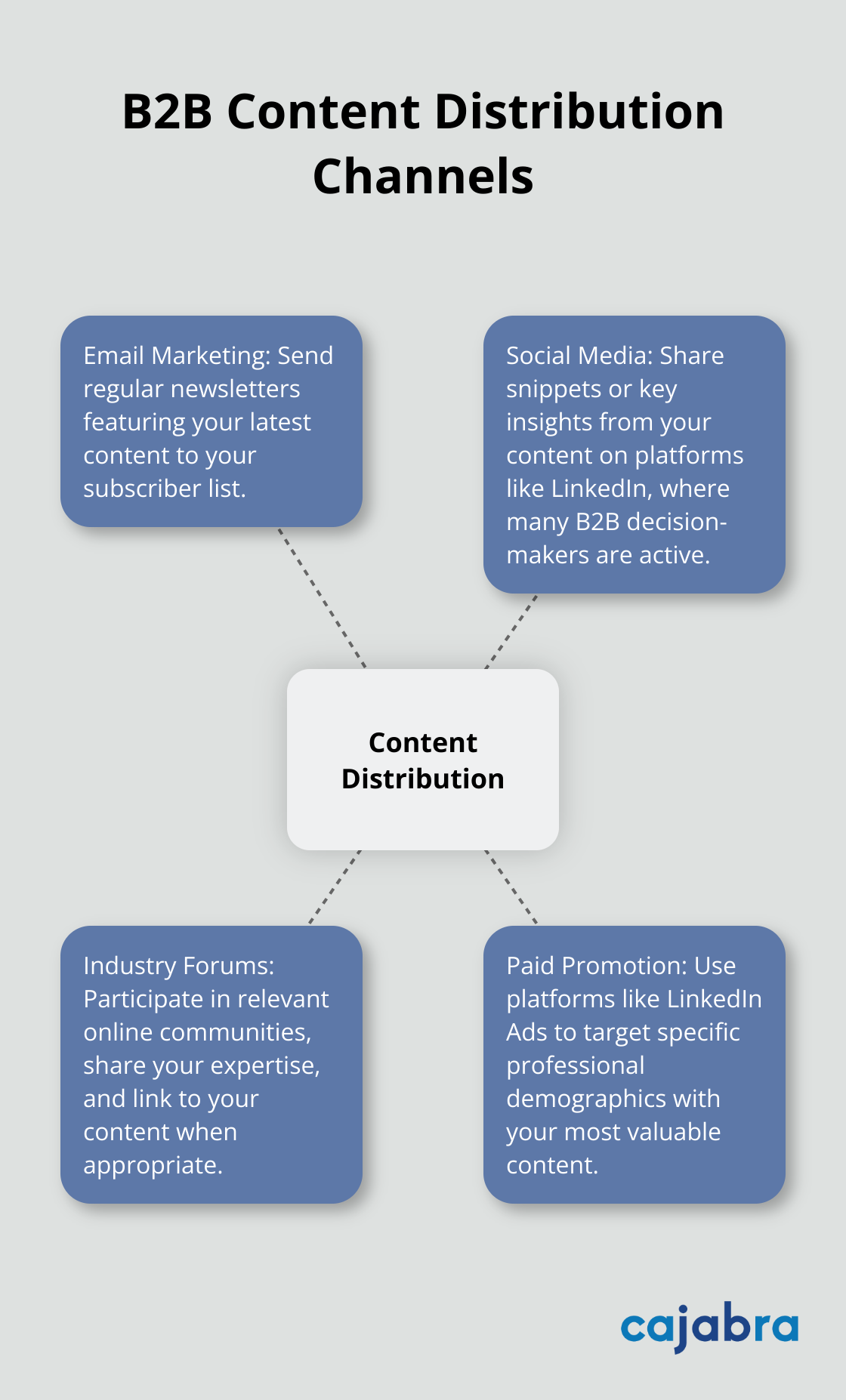
Different types of content may perform better on different platforms. A detailed white paper might work best through email, while a quick-tip infographic could gain traction on social media.
Measure and Analyze Performance
To understand the impact of your content marketing efforts, track key performance indicators (KPIs). These may include traffic metrics, bounce rate, conversion metrics, cost per lead (CPL), and customer acquisition cost. Tools like Google Analytics provide valuable insights into content performance.
Don't just collect data; use it to inform your strategy. If case studies consistently outperform other types of content, produce more of them. Similarly, if certain topics generate more engagement, explore those areas further in your content calendar.
Review and adjust your strategy based on these insights regularly. Content marketing requires ongoing refinement to stay effective and relevant.
Final Thoughts
A well-structured B2B content marketing plan forms the cornerstone of success in today's digital landscape. Companies that understand their audience, create valuable content, and distribute it strategically position themselves as industry leaders and drive meaningful results. Consistency proves key, as regular production of high-quality content builds trust and maintains audience engagement over time.
The world of B2B content marketing constantly evolves, requiring adaptability and readiness to adjust strategies based on performance data and industry trends. What works today might not be as effective tomorrow, so continuous learning and refinement become essential. Now is the time to put your B2B content marketing plan into action (start by defining goals, researching your audience, and creating a content calendar).
At Cajabra, we help accounting firms develop and execute effective B2B content marketing strategies. Our JAB System™ can move your firm from overlooked to overbooked in just 90 days, securing retainer-based clients and maximizing your marketing efforts. We handle all aspects of marketing, allowing you to focus on serving your clients.
Content is king, but without a solid plan, it's just noise. At Cajabra, LLC, we know that a well-crafted content development plan is the backbone of successful digital marketing.
In this post, we'll show you how to create an effective strategy that aligns with your business goals and resonates with your target audience. Get ready to transform your content game and drive real results.
Who Is Your Content For?
Pinpointing Your Ideal Reader
Creating detailed buyer personas forms the foundation of a successful content development plan. These semi-fictional representations of your ideal customers stem from market research and real data about existing clients. HubSpot's research indicates that using buyer personas can make websites 2-5 times more effective and easier to use for targeted users.
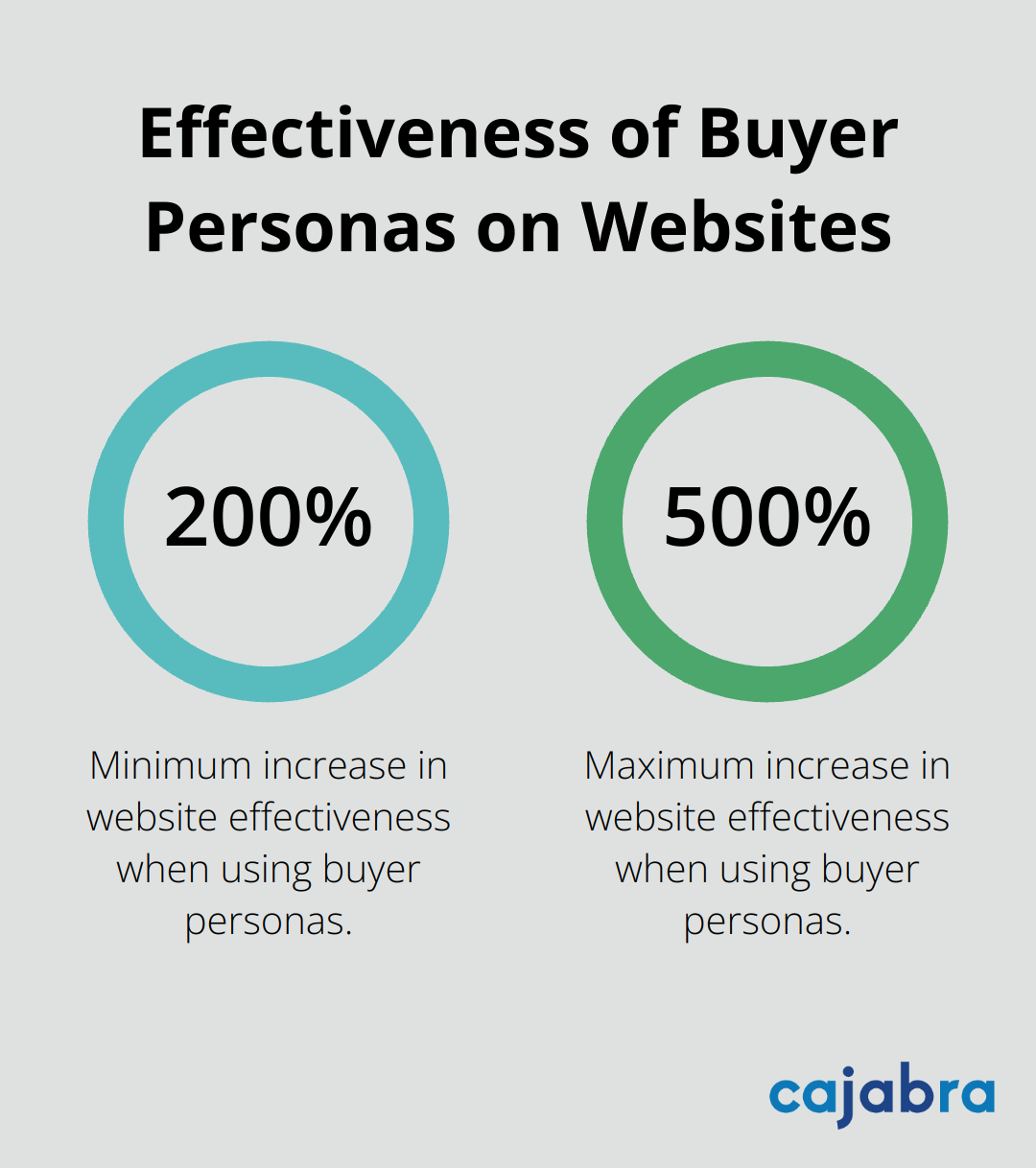
To build these personas, analyze demographics, behavior patterns, motivations, and goals. Use Google Analytics to gather data on your current audience. Conduct surveys or interviews with your best clients to understand their pain points and preferences.
Setting Clear Content Objectives
After identifying your audience, define your content goals. Do you want to increase brand awareness, generate leads, or boost sales? Each goal requires a different content approach.
For lead generation, create gated content like whitepapers or webinars. Eighty percent of business decision-makers prefer to get company information from a series of articles versus an advertisement.
Aligning Content with Business Goals
Your content should directly support your overarching business objectives. If your company aims to position itself as an industry thought leader, include in-depth analysis pieces and expert interviews in your content plan.
Use the SMART framework to set specific, measurable, achievable, relevant, and time-bound goals for your content. This approach ensures that every piece of content you create has a clear purpose and contributes to your bottom line.
Implementing Tracking Mechanisms
Set up tools like Google Analytics or specialized content analytics platforms to measure the effectiveness of your content. These tools provide valuable insights into how your audience interacts with your content.
Adapting Your Strategy
Review your metrics regularly and adjust your strategy based on the data. The most successful content plans evolve with changing audience needs and business goals.
As you refine your understanding of your audience and goals, you'll be well-positioned to develop a robust content strategy. Let's explore how to choose the right content types and formats to engage your target audience effectively.
Crafting Your Content Blueprint
Diversifying Your Content Portfolio
A well-structured content strategy forms the cornerstone of successful marketing. The first step in developing your strategy involves choosing the right mix of content types. Blog posts remain a staple, with 89% of marketers using them (according to the Content Marketing Institute). However, your strategy should extend beyond written content. Incorporate videos, as 71% of B2B marketers find them more effective than written formats. Infographics serve as another powerful tool, with 67% of B2B marketers leveraging them for quick information delivery.
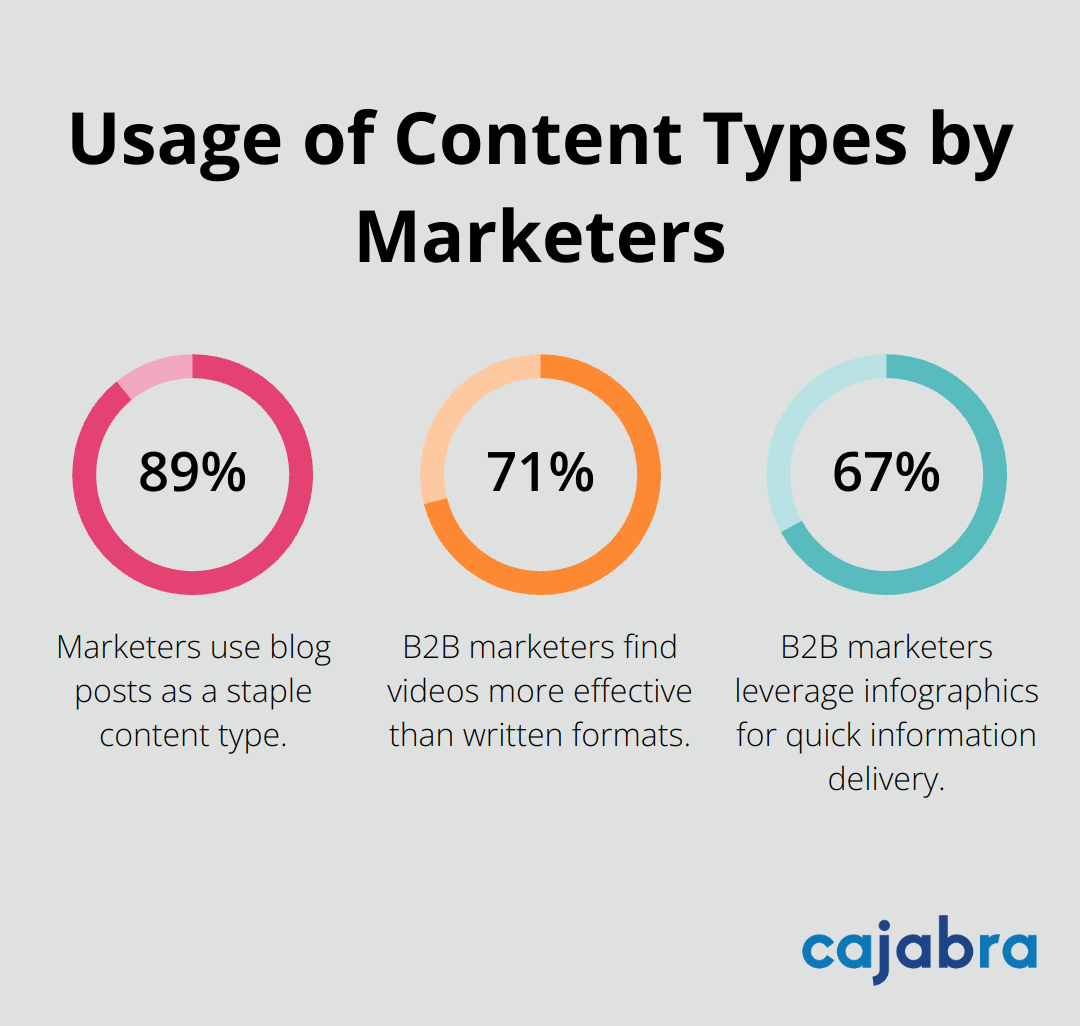
Case studies showcase your successes and build trust through real-world examples. Podcasts are gaining traction too, offering a personal touch that resonates with busy professionals who prefer audio content.
Mapping Out Your Content Journey
A content calendar serves as your roadmap to consistency. Tools like Asana or Trello help plan your content pipeline. If your blog isn't at least a year old, you should aim to publish 6-8 posts a month around a few important and promising topics.
Plan your content themes around key industry events, seasonal trends, and your product launches. This approach ensures your content remains timely and relevant. Leave room for reactive content that addresses breaking news or emerging trends in your industry.
Building Your Content Dream Team
Clear role assignment and responsibilities prove crucial for smooth execution. Designate a content strategist to oversee the big picture, writers to create compelling copy, and designers to bring visual elements to life. If you're a smaller team, consider outsourcing some tasks to fill expertise gaps.
Establish a clear workflow for content production. Tools like Planable can streamline this workflow, reducing bottlenecks and ensuring everyone aligns on project goals.
Measuring What Matters
Setting the right Key Performance Indicators (KPIs) is essential for tracking success. Focus on metrics that align with your business goals. For lead generation, track landing page visits and form completions. If brand awareness is your aim, monitor social shares and engagement rates.
Use tools like Google Analytics to measure website traffic and user behavior. For social media, platforms like Sprout Social offer in-depth analytics on audience engagement and content performance.
Review these metrics regularly – at least monthly – and use the insights to refine your strategy. A data-driven approach allows you to double down on what works and pivot away from underperforming tactics.
With a robust content strategy in place, you're ready to bring your content plan to life. The next section will explore effective implementation and distribution strategies to maximize the impact of your carefully crafted content.
How to Execute Your Content Plan
Research for Quality Content
Start with comprehensive research. Use BuzzSumo to identify trending topics in your industry. Analyze your competitors' content to find gaps you can fill. Engage with your audience through surveys or social media polls to understand their pain points and interests.
For accounting firms, topics related to tax law changes, financial technology, and business advisory services often generate significant interest. Set up Google Alerts for key industry terms to stay on top of breaking news and emerging trends.
Create Content That Converts
When you create content, focus on providing value to your audience. Use the skyscraper technique to improve upon existing content in your niche. For example, if there's a popular article on tax preparation tips, create a more comprehensive guide that includes expert insights and actionable advice.
Incorporate storytelling elements to make your content more engaging. Case studies are particularly effective for B2B audiences. Last year, B2B marketers said case studies/customer stories were the most effective types of content.

Optimize for Search Engines and Readers
SEO is essential for content visibility. Use tools like SEMrush or Ahrefs to conduct keyword research. Try long-tail keywords that have lower competition but high relevance to your target audience. For instance, "small business tax deductions for freelancers" is more specific (and potentially easier to rank for) than "tax deductions."
Structure your content for readability. Use headers, short paragraphs, and bullet points to break up text. Include relevant images, infographics, or videos to enhance engagement.
Maximize Content Reach
Distribution is key to content success. Use multiple channels to reach your audience. Share your content on social media platforms where your target audience is most active. For B2B content, LinkedIn is often the most effective platform, with 97% of B2B marketers using LinkedIn for content marketing.
Email marketing remains a powerful tool for content distribution. Segment your email list to send targeted content to specific groups.
Consider repurposing your content for different formats. Turn a blog post into an infographic or a video to cater to different content consumption preferences. This approach can extend the life of your content and reach a wider audience.
Track and Tweak Performance
Monitor your content performance regularly using analytics tools. Google Analytics provides valuable insights into website traffic and user behavior. Social media platforms offer native analytics to track engagement metrics.
Pay attention to metrics that align with your goals. For lead generation, focus on conversion rates and form submissions. For brand awareness, track social shares and reach.
Use A/B testing to optimize your content strategy. Test different headlines, content formats, or call-to-actions to see what resonates best with your audience. Continuously refine your approach based on these insights to improve your content's effectiveness over time.
Final Thoughts
A well-crafted content development plan forms the cornerstone of successful digital marketing. It creates a solid foundation through audience understanding, clear objectives, and alignment with business goals. The plan's power manifests in its implementation, boosting effectiveness through research, quality content creation, and optimization for search engines and readers.
Flexibility remains key in content marketing as the digital landscape evolves. We recommend regular review of metrics and strategy adjustments based on audience preferences, industry trends, and technological advancements. Continuous improvement should drive your content efforts, refining your approach through data and feedback collection.
At Cajabra, we specialize in helping accounting firms create and execute effective content strategies. Our services (including the JAB System™) aim to help accountants attract high-value, retainer-based clients. We handle content development and marketing intricacies, allowing you to focus on serving your clients.
Client engagement specialists are the backbone of successful business relationships. At Cajabra, LLC, we've seen firsthand how these professionals bridge the gap between companies and their customers.
This role demands a unique blend of skills, from communication prowess to tech-savvy expertise. If you're looking to become a client engagement specialist, you're in the right place.
Mastering Essential Skills for Client Engagement
Communication: The Foundation of Client Relationships
Effective communication forms the bedrock of client engagement. It extends beyond clear speech to encompass active listening and understanding client needs. A strong, personalized introduction that captures attention, establishes credibility, and invites client participation is key to successful client engagement.
Problem-Solving: Transforming Challenges into Opportunities
Client engagement specialists must excel at problem-solving. This skill involves addressing current issues and anticipating potential challenges. We suggest a proactive approach through regular "what-if" scenario exercises with your team. This practice helps develop contingency plans for various situations.
Emotional Intelligence: The Hidden Advantage
Emotional intelligence (EQ) plays a powerful role in client engagement. A high EQ enhances your ability to manage interpersonal relationships, which is crucial for fostering positive team dynamics and client interactions.
Adaptability: Flourishing in a Dynamic Environment
The business landscape evolves constantly, requiring client engagement specialists to keep pace. We advise dedicating time to stay updated on industry trends and new technologies. This habit enhances your ability to provide relevant solutions to clients.
Tech Proficiency: Harnessing Tools for Success
In today's digital age, proficiency in CRM software and other digital tools proves essential. Client engagement skills are the backbone of successful business relationships. Client engagement specialists who master these technologies can manage their clients more effectively. Start by thoroughly learning one CRM system, then expand your knowledge to other popular platforms in your industry.

The development of these skills sets the stage for success in client engagement. The next section will explore the educational pathways and qualifications that complement these essential skills, further preparing you for a thriving career in this field.
Paving Your Path to Client Engagement Success
Degree Programs That Open Doors
A bachelor's degree in business administration, marketing, or communications provides a solid foundation for aspiring client engagement specialists. These programs offer courses in customer relationship management, business analytics, and strategic communication - all vital skills in this role.
Don't feel limited if your degree is in a different field. Many successful client engagement specialists come from diverse educational backgrounds. Your ability to apply knowledge to real-world client scenarios matters most.
Certifications That Set You Apart
Professional certifications can give you a competitive edge in the job market. The Certified Customer Experience Professional (CCXP) certification, offered by the Customer Experience Professionals Association, is highly regarded in the industry. To maintain the credential, each CCXP must complete and document ongoing training in customer experience.
Another valuable certification is the Project Management Professional (PMP). It demonstrates your ability to manage complex projects - a skill often required when handling large client accounts. Managing client expectations will lead to a stable relationship between clients and the project manager.
Embracing Lifelong Learning
The field of client engagement constantly evolves, making continuous learning essential. Online platforms like Coursera and edX offer courses on customer relationship management and digital marketing strategies. These can help you stay updated with the latest trends and technologies.
Industry conferences such as the Customer Success Summit provide opportunities to learn from experts and network with peers. Attendance at these events can expose you to new ideas and best practices in client engagement.
Professionals who consistently invest in their education and skills development tend to excel in client engagement roles. They bring fresh perspectives and innovative solutions to client challenges (ultimately driving better results for both the client and the company).
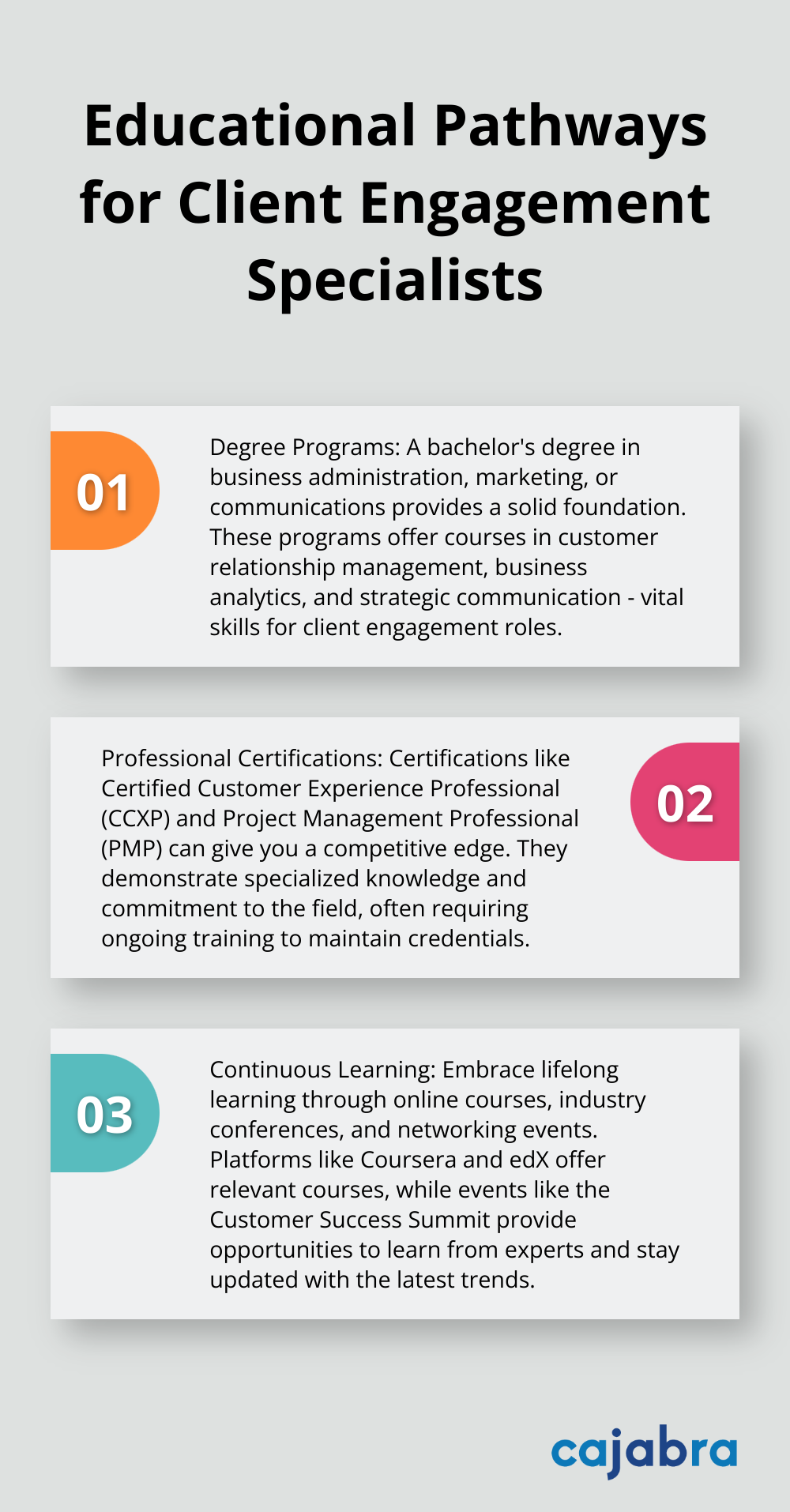
As you build your educational foundation and acquire certifications, the next step involves gaining practical experience. Let's explore how to build real-world skills that complement your theoretical knowledge and set you on the path to becoming a successful client engagement specialist.
Gaining Real-World Client Engagement Experience
Start in Entry-Level Customer Service Roles
Begin your career in customer-facing positions. These roles provide valuable experience in handling client inquiries, resolving issues, and maintaining positive relationships. Customer service-related jobs such as client relations associate, client services coordinator, and customer service representative offer excellent starting points for aspiring client engagement specialists.
Look for positions in call centers, retail, or online support teams. These jobs will help you develop essential skills like active listening, problem-solving, and maintaining composure under pressure. They also offer insights into common client concerns and effective resolution strategies.
Pursue Internships and Apprenticeships
Internships and apprenticeships in client-facing positions offer golden opportunities to gain industry-specific experience. Many companies (including top firms like Deloitte and PwC) offer structured programs for aspiring client engagement specialists.
During these programs, you'll work alongside experienced professionals, attend client meetings, and contribute to real projects. This exposure not only builds your skills but also helps you understand the nuances of client relationships in a professional setting.
Volunteer for Client-Centric Projects
Volunteering for client-centric projects can significantly boost your experience and network. Non-profit organizations often need help with donor relations, event planning, and community outreach - all of which involve client engagement skills.
The American Red Cross offers volunteer positions in donor recruitment and retention. These roles can help you develop persuasion skills and learn how to maintain long-term relationships, which are important in client engagement.
Attend Industry Events
Industry events keep you current with trends and expand your professional network. The Customer Contact Week conference, held annually in Las Vegas, offers workshops on implementing best practices in communication, trust-building, and team engagement to drive higher productivity and retention across customer service teams.
Participate actively in these events. Ask questions during Q&A sessions, engage in discussions during networking breaks, and follow up with connections afterward. This proactive approach can lead to mentorship opportunities or even job leads.
Develop a Personal Brand
Create a strong personal brand that showcases your client engagement skills. Maintain an active LinkedIn profile, share industry insights, and engage with thought leaders in the field. This visibility can attract potential employers and clients (and position you as a rising star in client engagement).
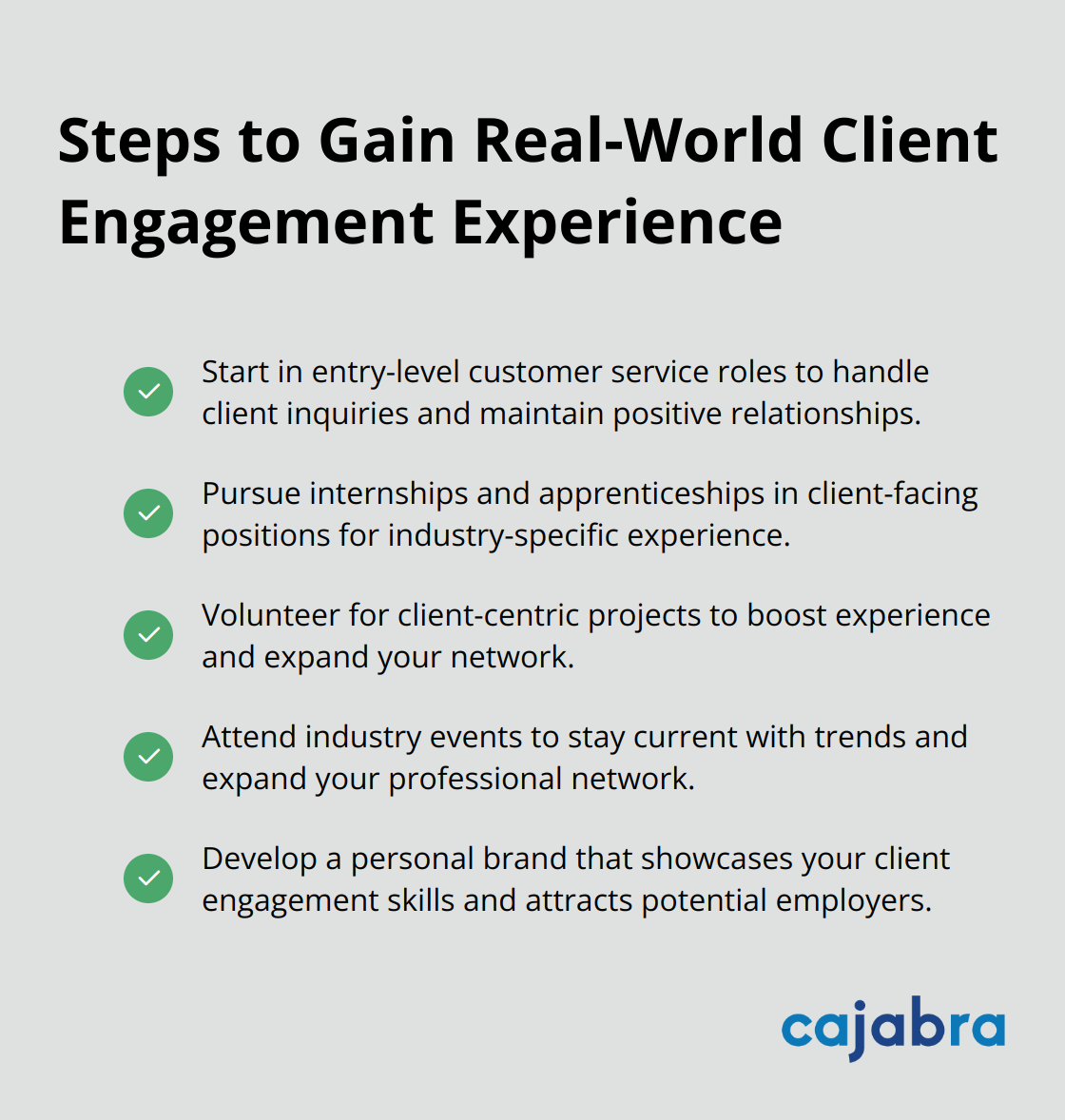
Final Thoughts
Becoming a Client Engagement Specialist demands dedication, continuous learning, and a passion for building strong relationships. The skills we've discussed form the foundation of success in this field. When combined with relevant education, certifications, and hands-on experience, these skills will set you apart in the competitive world of client engagement.
The field of client engagement constantly changes. You must stay current with industry trends, technologies, and best practices for long-term success. Embrace opportunities for growth through formal education, professional development courses, or simply staying curious about your clients and their industries.
At Cajabra, we understand the importance of effective client engagement, especially in specialized fields like accounting. Our JAB System™ helps accounting firms transform their client relationships (moving from overlooked to overbooked in just 90 days). This approach highlights the power of strategic client engagement in driving business success.
Content marketing is a powerful tool for businesses to attract and engage their target audience. At Cajabra, LLC, we've seen firsthand how a well-crafted content marketing plan can drive results.
In this post, we'll guide you through the essential steps to create an effective content marketing plan that aligns with your business goals and resonates with your audience.
What Are Your Content Marketing Goals?
Setting SMART Objectives
Clear, well-defined goals form the foundation of every successful content marketing plan. Without them, your content efforts may lack focus and effectiveness. At Cajabra, LLC, we recommend using SMART goals (Specific, Measurable, Achievable, Relevant, and Time-bound) to guide your strategy.
For example, instead of a broad goal like "increase website traffic," try to set a more specific objective: "Increase organic traffic by 25% within the next six months through weekly blog posts and bi-monthly video content." This approach provides a clear target and timeline for your efforts.
A study by CoSchedule highlights the importance of goal-setting: marketers who set goals are nearly 4 times more likely to report success than those who do not. This statistic underscores the value of establishing clear objectives for your content strategy.
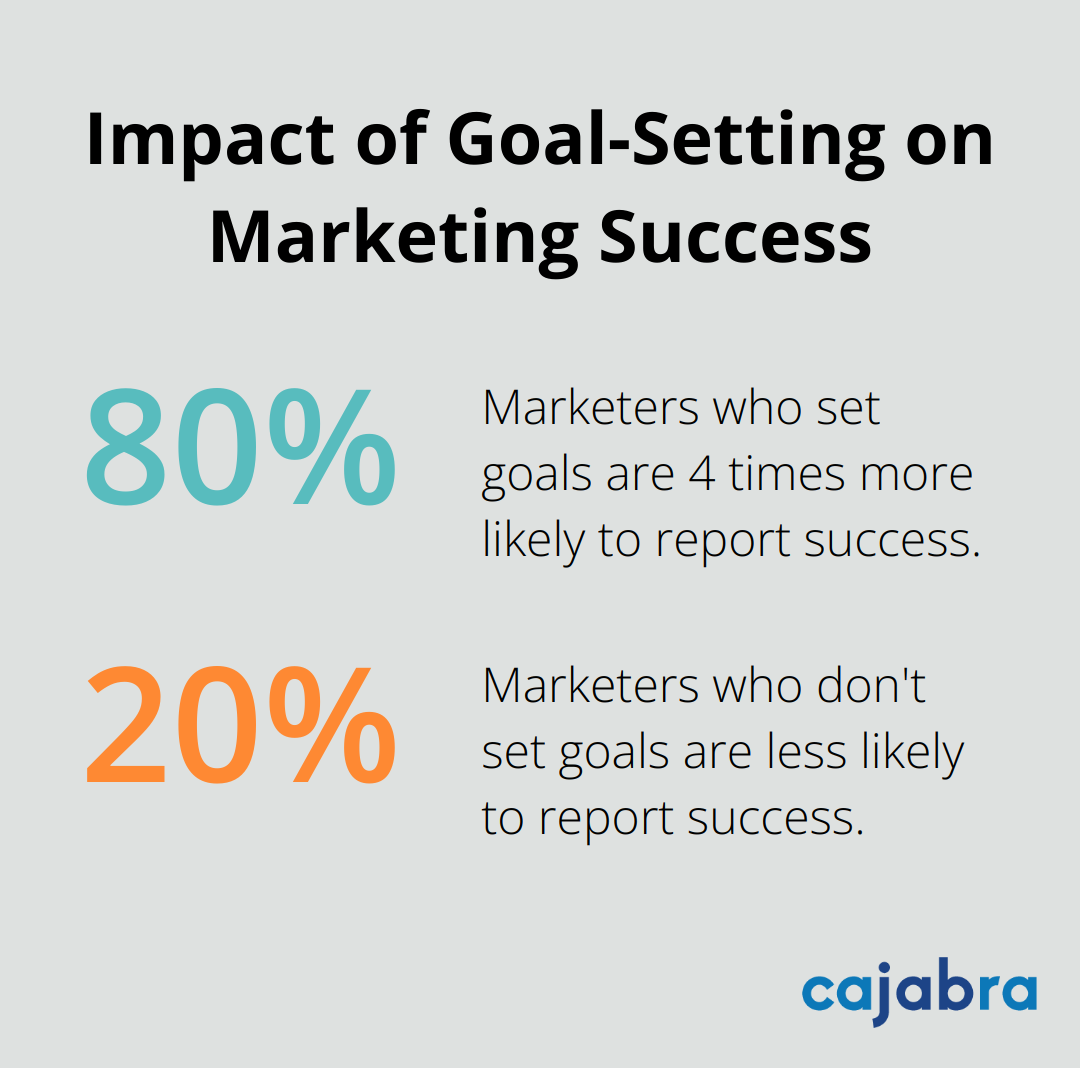
Understanding Your Audience
Your content won't connect if you don't know your audience. Create detailed buyer personas based on real data, not assumptions. Use tools such as Google Analytics, social media insights, and customer surveys to collect information about your audience's demographics, behaviors, and pain points.
This data-driven approach allows you to tailor your content to address specific needs and preferences, increasing its relevance and impact.
Aligning with Business Objectives
Your content marketing goals should directly support your overall business objectives. If your company aims to increase market share in a specific industry, your content strategy might focus on establishing thought leadership in that sector.
HubSpot's State of Marketing Report reveals that 70% of marketers actively invest in content marketing. To stand out in this crowded field, your strategy must align tightly with your unique business goals.
Measuring Success
Establish key performance indicators (KPIs) to track your progress towards your content marketing goals. These might include metrics such as:
- Website traffic
- Engagement rates (time on page, bounce rate)
- Conversion rates
- Social media shares and comments
- Email newsletter subscriptions
Regular analysis of these metrics (ideally on a monthly or quarterly basis) will help you identify what's working and what needs adjustment in your content strategy.
Adapting to Change
The digital landscape evolves rapidly, and your content marketing goals should reflect these changes. Stay informed about industry trends, emerging platforms, and shifts in consumer behavior. This knowledge will help you adapt your goals and strategies to remain relevant and effective.
As you move forward with your content marketing plan, the next crucial step involves developing a robust content strategy and editorial calendar. This process will help you translate your goals into actionable content creation and distribution plans.
How to Build Your Content Strategy and Calendar
Select Your Content Mix
Start by choosing content types that resonate with your audience. The Content Marketing Institute reports that 46% of marketers think their content marketing budget will increase in 2025 compared to 2024. Popular formats include blog posts, videos, infographics, and podcasts. Each format serves different purposes and appeals to various audience segments.

Long-form blog posts excel at in-depth explanations and SEO. Videos quickly engage viewers and explain complex concepts visually. Infographics distill complex data into digestible visuals (perfect for social media sharing). Podcasts offer a convenient way for busy professionals to consume content on-the-go.
Plan Themes and Topics
Develop a content theme for each month or quarter. This approach maintains consistency and allows for in-depth topic exploration. Use tools like Google Trends, BuzzSumo, or SEMrush to identify popular industry topics. Also, leverage insights from your sales and customer service teams to address common questions and pain points your audience faces.
For example, a finance industry content calendar might look like this:
- January: "New Year Financial Planning"
- February: "Tax Preparation Tips"
- March: "Investment Strategies for Q2"
This thematic approach simplifies individual content piece brainstorming and ensures a cohesive content strategy.
Create Your Publishing Schedule
Consistency drives success in content marketing. Companies that blog get 55% more website visitors than businesses that don't. However, quality should never take a backseat to quantity.
Create a realistic publishing schedule based on your resources. If you're just starting, try to produce 1-2 high-quality pieces per week. As you grow, you can increase frequency. Use project management tools like Trello or Asana to track content from ideation to publication.
Factor in lead time for content creation, editing, and approval processes. Also, consider timing your content releases to coincide with industry events, holidays, or other relevant occasions to maximize impact.
Assign Roles and Responsibilities
Clear role assignment ensures smooth content production and distribution. Identify team members responsible for:
- Content ideation and research
- Writing and editing
- Graphic design and multimedia production
- SEO optimization
- Social media promotion
- Performance tracking and analysis
Clearly define each role's responsibilities and establish communication channels for seamless collaboration.
Implement a Content Review Process
A robust review process maintains content quality and brand consistency. Establish a workflow that includes:
- Initial draft submission
- Editorial review and feedback
- Revisions based on feedback
- Final approval
- SEO optimization check
- Publication and distribution
This process (when followed consistently) helps prevent errors, ensures alignment with brand guidelines, and maintains high content standards.
With your content strategy and calendar in place, the next step involves implementing effective content creation and distribution processes. These processes will bring your carefully planned strategy to life and ensure your content reaches and engages your target audience.
How to Execute Your Content Plan
Streamline Your Content Creation
Establish a clear workflow for content production. Create detailed briefs for each piece of content. These briefs should outline the topic, target audience, key points to cover, and desired outcomes. This approach ensures all team members align on the content's purpose and direction.
Set up a content calendar using tools like Trello or Asana. Assign tasks to team members and set realistic deadlines. An effective content workflow is essential for a successful marketing strategy.
Optimize for Search Engines
SEO plays a vital role in content visibility. Conduct keyword research using tools like SEMrush or Ahrefs to identify relevant, high-volume search terms. Incorporate these keywords naturally into your content, including headers, meta descriptions, and image alt text.
Focus on creating comprehensive, high-quality content that answers user queries. Google's algorithm favors in-depth, authoritative content. Search engine optimization (SEO) optimizes web content and site architecture to improve visibility in organic search engine results.
Diversify Your Distribution Channels
Don't rely on a single channel to distribute your content. Use a mix of owned, earned, and paid media to maximize reach. Share your content on social media platforms where your audience is most active.
Email marketing remains a powerful distribution channel. Segment your email list and personalize content to increase engagement.
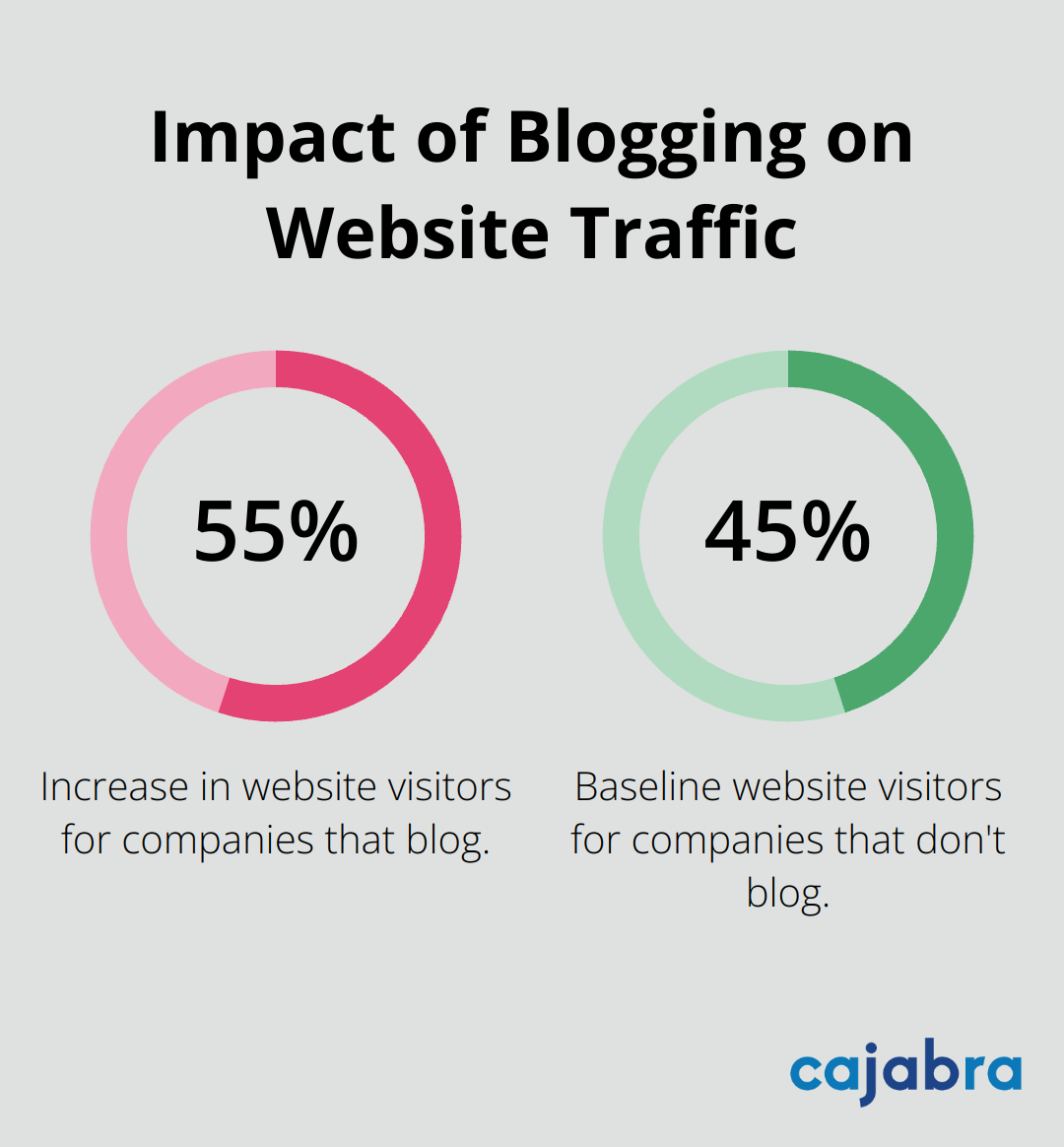
Repurpose and Recycle Content
Maximize the value of your content by repurposing it across different formats. Transform a blog post into an infographic, podcast episode, or video. This approach not only saves time but also caters to different content consumption preferences.
You could transform a detailed guide into a series of social media posts, an email course, or a webinar. This strategy allows you to reach a wider audience and reinforce your message across multiple touchpoints.
Measure and Iterate
Analyze your content performance regularly using tools like Google Analytics. Track key metrics such as page views, time on page, bounce rate, and conversions. Use these insights to refine your content strategy and focus on what resonates most with your audience.
A/B testing can be particularly effective. Test different headlines, content formats, or distribution times to optimize your content's performance.
Final Thoughts
A content marketing plan requires careful planning, execution, and ongoing refinement. You must define clear goals, understand your audience, and align your strategy with business objectives. The implementation of your plan through streamlined content creation, SEO optimization, and diverse distribution channels will maximize the impact of your content.
Regular measurement and analysis of performance data allow you to improve and adapt your strategy to changing market conditions. Consistency proves key in content marketing, so stick to your publishing schedule and maintain high-quality standards across all content pieces. You should assess your content's performance regularly and adjust your approach based on data-driven insights.
At Cajabra, we've witnessed how a well-executed content marketing plan can transform an accounting firm's online presence and client acquisition. Our marketing services for accountants leverage content marketing to help firms stand out in a competitive landscape. A robust content strategy will position your business as an industry leader, attract ideal clients, and drive sustainable growth.
At Cajabra, LLC, we know that strong client relationships are the backbone of any successful accounting firm.
Client engagement strategies are essential for building trust, loyalty, and long-term partnerships with your clients.
In this post, we'll explore practical ways to boost client engagement and transform your accounting practice into a client-centric powerhouse.
What Is Client Engagement?
Definition and Importance
Client engagement refers to the ongoing interaction between an accounting firm and its clients. It involves the creation of strong, lasting relationships that transcend simple transactions. At its core, client engagement actively involves clients in the financial process, keeps them informed, and provides value that exceeds their expectations.
For accounting firms, client engagement is not just a nice-to-have-it's a necessity. Engaged clients tend to remain loyal, recommend services, and even increase their spending. However, according to Gallup, only 29% of B2B customers are fully engaged and 71% are at risk of leaving for a competitor.
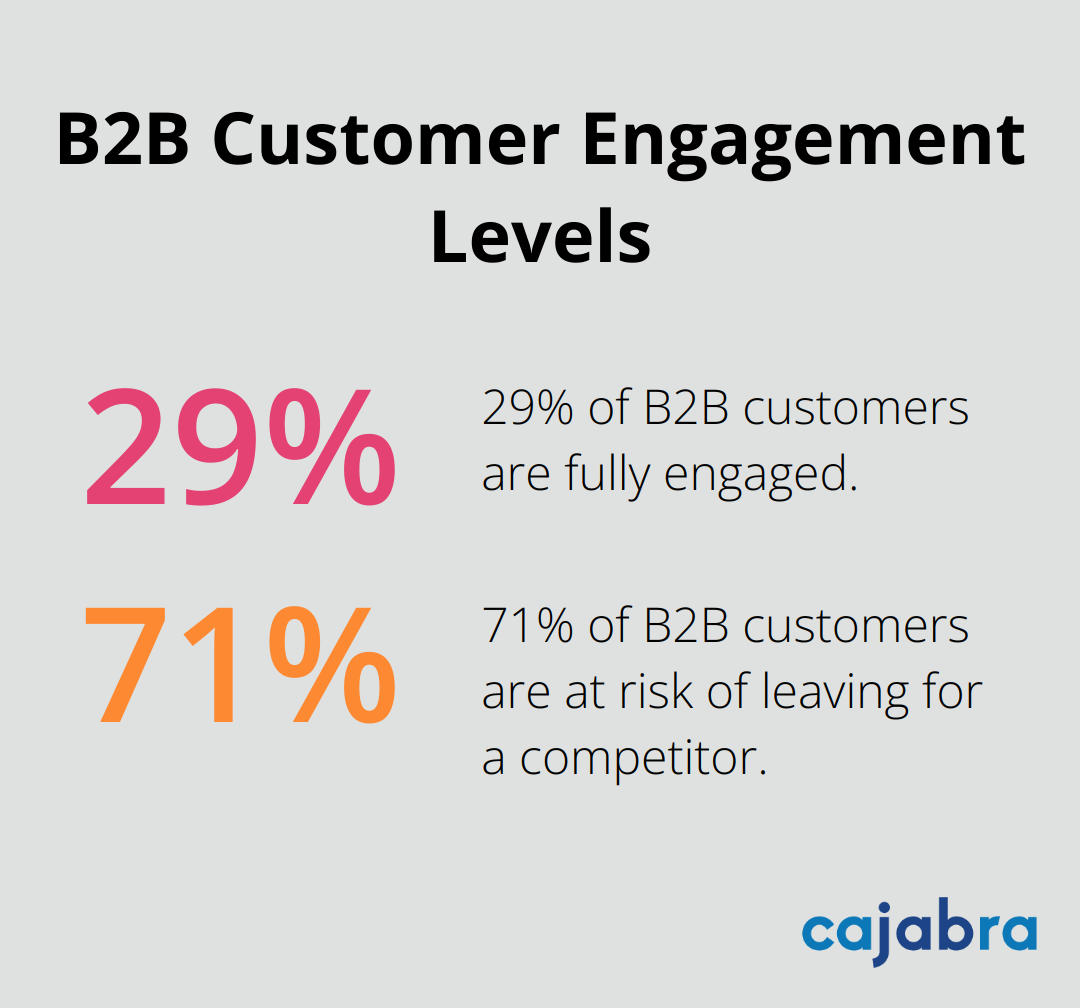
In the accounting world, where trust is paramount, engagement forms the foundation for long-term partnerships. It's not just about number crunching; it's about becoming a trusted advisor. When clients feel valued and understood, they're more likely to seek additional services, thus increasing the firm's revenue potential.
Key Metrics for Measuring Engagement
To enhance client engagement, you must measure it. Here are some key metrics to track:
- Client Retention Rate: This percentage shows how many clients continue to use your services over time. A high retention rate often indicates strong engagement.
- Net Promoter Score (NPS): This metric measures the likelihood of clients recommending your firm to others (a good indicator of client satisfaction and loyalty).
- Frequency of Communication: This tracks how often you interact with clients outside of regular reporting periods. More frequent, meaningful interactions often correlate with higher engagement.
- Service Utilization: This monitors which services each client uses. Engaged clients are more likely to take advantage of multiple service offerings.
- Response Time: This measures how quickly you respond to client inquiries. Faster response times can lead to higher client satisfaction and engagement.
Actionable Steps to Boost Engagement
- Implement a Client Feedback System: Identify gaps and pain points. Map the client journey from onboarding to invoicing. Where are the delays? Where is communication inconsistent?
- Personalize Your Communication: Use client relationship management (CRM) software to tailor your messages based on each client's history and preferences.
- Offer Value-Added Services: Try providing financial planning workshops or industry-specific insights to demonstrate your expertise beyond basic accounting tasks.
- Leverage Technology: Use digital tools (such as client portals or mobile apps) to enhance communication and streamline processes.
- Educate Your Clients: Offer resources (like webinars or newsletters) that help clients better understand their financial situation and the value of your services.
As we move forward, it's important to consider how these engagement strategies can be effectively communicated to clients. In the next section, we'll explore communication techniques that can significantly enhance your client relationships and drive engagement to new heights.
How to Communicate More Effectively with Clients
At Cajabra, LLC, we've witnessed the transformative power of effective communication in client relationships. Quality, relevance, and value trump mere frequency. Here's how you can elevate your communication game:
Personalize Your Approach
Client communication isn't one-size-fits-all. Some clients prefer emails, others phone calls, and some value face-to-face meetings. A Salesforce study revealed that 66% of customers expect companies to understand their unique needs and expectations. Learn each client's preferences and tailor your approach accordingly.
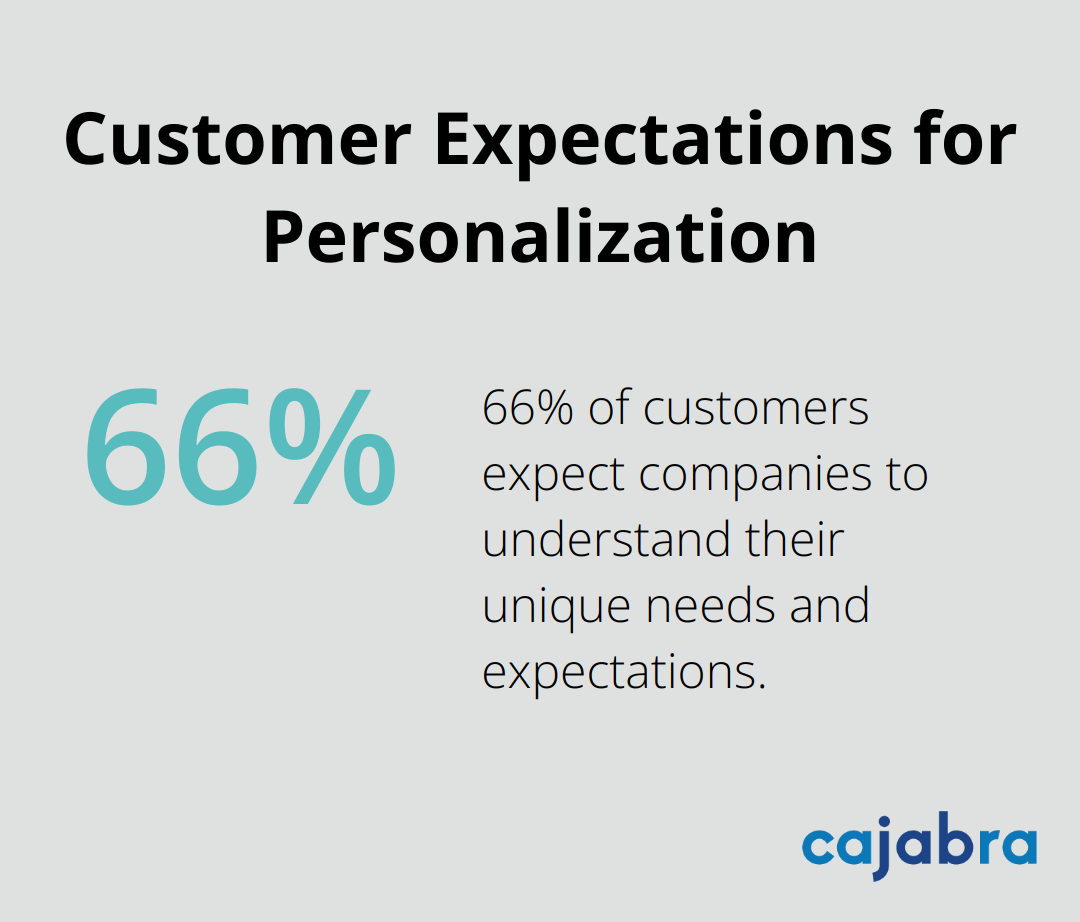
For example, a tech-savvy startup might appreciate quick updates via a messaging app. Conversely, a traditional business might value detailed monthly reports sent via email.
Establish a Regular Check-in Schedule
Consistency strengthens client relationships. Regular Check-ins with Clients can significantly impact client loyalty in the financial services sector. Implementing a robust Customer Retention Checklist can help you establish a consistent check-in schedule tailored to each client's needs and account complexity.
These check-ins should extend beyond numbers. Discuss their business goals, challenges, and how your services help them achieve their objectives. This proactive approach demonstrates your investment in their success beyond balancing books.
Use Technology for Seamless Communication
In our digital age, technology is essential for efficient communication. Client portals provide 24/7 access to financial documents, reports, and other vital information. This transparency builds trust and saves time for both parties.
Consider implementing a customer relationship management (CRM) system. A good CRM helps you track client interactions, set reminders for follow-ups, and ensures no important communication slips through the cracks.
Create Valuable Content
Content creation powerfully engages clients and showcases your expertise. This could include blog posts about tax updates, video tutorials on using accounting software, or infographics explaining complex financial concepts.
Try creating a monthly newsletter with industry insights, tax tips, and updates on your firm's services. This keeps you top-of-mind with clients and positions you as a valuable resource.
The goal of your content should be to educate and inform (not sell). Providing genuine value naturally strengthens relationships with existing clients and attracts new ones.
These strategies can significantly enhance your client communication. It's about creating a dialogue, not a monologue. Focus on personalization, consistency, technology, and value-added content to build stronger, more engaged client relationships.
Now that we've covered effective communication strategies, let's explore how providing value-added services can further boost client engagement and solidify your position as a trusted advisor.
How to Add Value Beyond Traditional Accounting
Embrace Advisory Services
The accounting landscape demands more than number-crunching. A survey by Sage reveals that 79% of accountants are confident they can provide business management and advisory services. This shift presents an opportunity to expand service offerings.
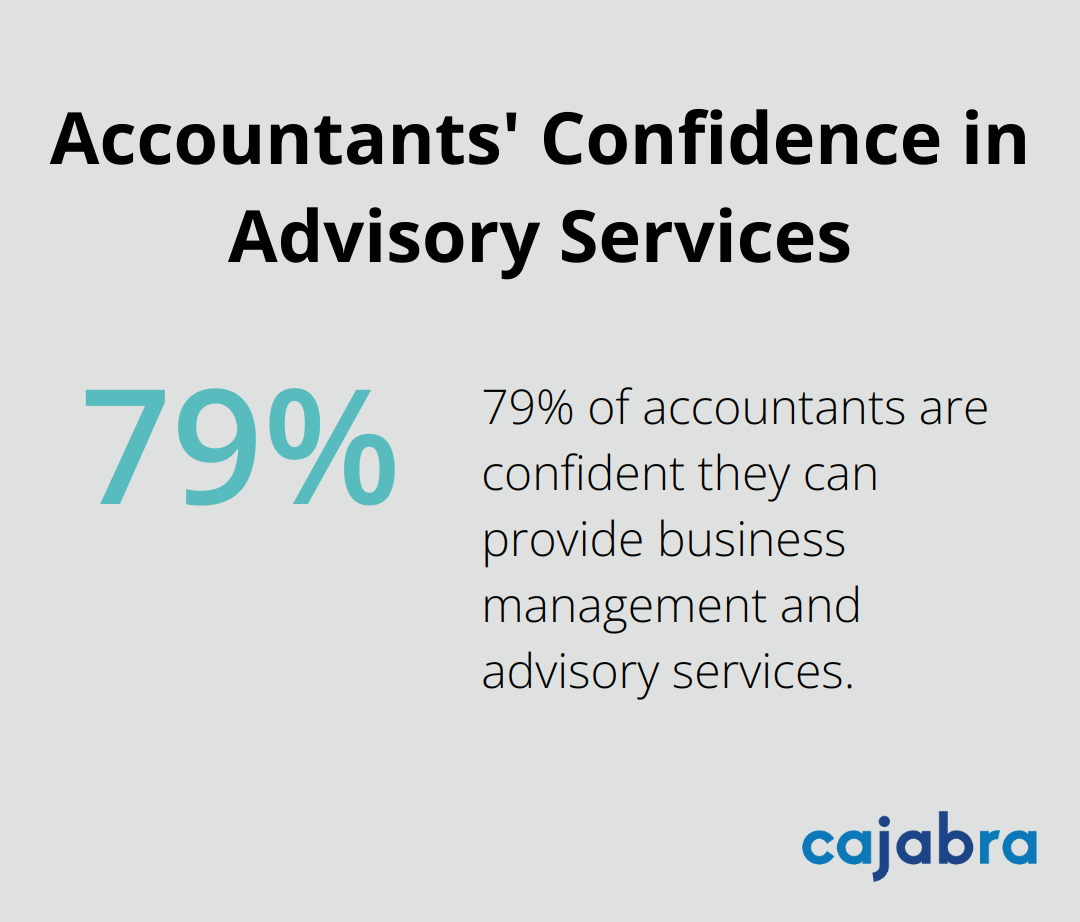
Accountants should provide strategic business planning, risk management, or IT consulting services. For example, help clients select and implement accounting software that integrates with their existing systems to improve overall financial management.
Implement Proactive Financial Planning
Don't wait for clients to present problems. Take initiative to forecast potential financial issues and offer solutions before they become critical. This approach can save clients money and stress, solidifying your role as an indispensable partner.
Try conducting quarterly financial health checks for clients. Identify areas for improvement and potential risks. This regular engagement keeps you at the forefront of clients' minds and showcases your ongoing value.
Leverage Data Analytics
In today's data-driven world, accountants who transform numbers into actionable insights become invaluable. Invest in data analytics tools and training to offer clients a deeper understanding of their financial position and market trends.
Use predictive analytics to forecast cash flow, helping clients make informed decisions about investments or expansions. A study investigates the impact of Big Data Analytics (BDA) on accounting manipulation in an emerging market context.
Educate Your Clients
Knowledge empowers clients, and financial literacy boosts engagement. Host workshops, webinars, or create online courses covering topics like tax planning, financial forecasting, or understanding financial statements.
These educational initiatives provide value to clients and position you as an expert in your field. A Financial Planning Association study found that 78% of clients are more likely to refer their financial advisor if they offer educational resources.
Customize Your Approach
Every client has unique needs and goals. Tailor your value-added services to each client's specific situation. This personalized approach (which may include industry-specific insights or specialized financial modeling) demonstrates your commitment to their success.
By implementing these strategies, you can stay connected with your clients, understand their needs, and provide value beyond basic accounting services.
Final Thoughts
Client engagement strategies form the foundation of success for accounting firms in today's competitive landscape. Personalized communication, technology-driven interactions, and value-added services transform firms into client-centric powerhouses. Regular check-ins, data-driven insights, and proactive financial planning demonstrate a commitment to client success beyond traditional accounting tasks.
The long-term benefits of improved client engagement include increased loyalty, more referrals, and higher revenue potential. Engaged clients remain more receptive to new service offerings, which creates opportunities for firms to expand and diversify. These advantages lead to a more stable client base and a stronger reputation in the industry.
We at Cajabra, LLC developed the JAB System™ to help accountants secure retainer-based clients and maximize revenue from existing relationships. Our specialized marketing services for accounting firms allow you to focus on serving your clients while we handle your marketing needs. Take action now: assess your current client engagement levels, identify areas for improvement, and implement the strategies discussed in this post.
